OPHTHALMIC LABS & INDUSTRY
We help you to stay in contact
4/2023
▶ Special topic: Data Handling & Security
AI and machine learning algorithms
Highest level of lens personalization thanks to “big data” and recent scientific findings

▶ MAFO live on site SLUGFest 2023 — first-hand information and visions for the future Leica Eyecare — back to its roots
ALL-IN-
▶ Market Survey
Dip- and spin hard coating machines



M dulo Center
Imagine one single machine featuring all the technology to surface 80 lenses/hour, in just 72 sq. f t. (7m²). This is Modulo Center ONE. The compact all-in-one surfacing center is a full-fledged production line without limitations: a milling station // a lathe turning station // one or two 4-spindle polishing units // a CO₂ or excimer laser. Modulo Center ONE features highly advanced process technology, based on robust and reliable components proven in hundreds of installations across the globe.
The all-in-one surfacing center substantially saves time, running all processes simultaneously and perfectly synchronized – even milling and lathe turning. And with the chambers placed right next to one another, the smart automation transfers the lenses in virtually no time. There is no faster way to surface a lens.



The dedicated Control Center (MES) informs at a glance about the current status of the machine, production parameters, and efficiency.
Labs can now run larger scale productions even in small locations and under nonindustrial conditions. Little to no operator intervention is needed as the center works fully automated with all essential components on board. Simply put: Blank in, surfaced lens out.
ISSN 1614-1598 66527 Volume 19
Eyepress Fachmedien GmbH Saarner Str. 151 45479 Muelheim a. d. Ruhr 66527 Germany
www.schneider-om.com
in 1 hour 72 sq.ft. 80 lenses 4 processes
CHC1000 - Maximum Output, Minimum Effort



The CHC1000 is the ultimate unit for large scale cleaning and hard coating of lenses for customers that need to produce high volumes easily.


When fully loaded, the CHC1000 is capable of producing up to 1100 lenses per hour, with the system comprising of 10 stages of effective cleaning and drying, followed by a twin dip coating system for hard coating.


Unleash your full potential with the CHC1000
t: +44 (0) 1462 491616

e: sales@optimal-technologies.com


www.optimal-technologies.com
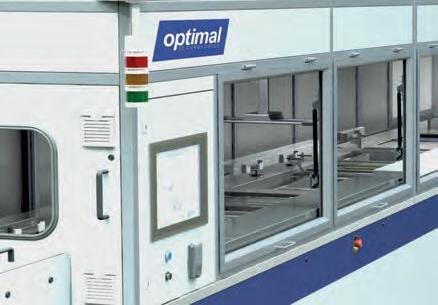

 Hanna Diewald Chief editor
Hanna Diewald Chief editor

Tell us your opinion, ideas and suggestions: hanna.diewald@mafo-optics.com
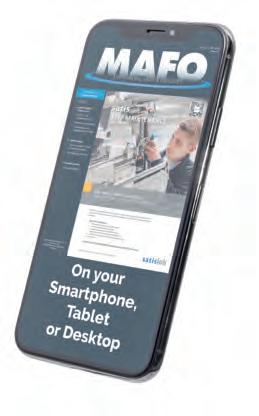
Artificial intelligence everywhere
At the beginning of 2019, we asked the ophthalmic optics industry what relevance AI has. At the time, most experts agreed: AI plays almost no role in our industry! In general, many people back then, only had a theoretical knowledge of the term. It was filed away under “futuristic technology” for trendy companies like Tesla.

Now, just four years later, the situation has been turned on its head. According to Statista, the AI tool ChatGPT reached the threshold of one million users in just five days. By comparison, other popular online services such as Instagram or Spotify took months to achieve this. Whether you are doing research for your boss or searching for help with a school essay – AI can seemingly take on anything. The upheaval of AI in the ophthalmic industry did not happen overnight, as with ChatGPT, but still — there is now hardly any machine- or lens-manufacturer that has not jumped on the bandwagon. Today, almost every company uses – and advertises the use of – AI in their products. Lens designs can be enhanced thanks to the technology and production processes optimized. For example, AI can refer back to huge databases of “defects” to spot errors during automatic lens inspection.
AI is also one focus of this issues special topic Data Handling & Security which adresses the opportunities offered by this technology.
▶ Gaetano Volpe and Pasquale Fanelli of ProCrea Tech discuss the
use of AI and machine learning in the design of spectacle lenses.
▶ In another article, Manuela Weinreich describes how Zeiss lenses are becoming even more customized thanks to Big Data.
▶ And we summarized some important facts about ChatGPT in professional life.
In our industry, AI, machine learning and similar technologies can thus be used in a wide variety of profitable ways.
It is equally self-evident that a technology that can flood a market so quickly and so comprehensively may also harbor risks. Warnings about the risks of using AI, and the need for regulation, have come from many different quarters – from prominent researchers to the World Health Organization. And if you ask ChatGPt directly, even the AI itself refers to five risks: spreading misinformation, reinforcing prejudices, misuse, privacy and dependence on AI systems.
That AI could suddenly replace the skills of human beings overnight is nonetheless an illusion, or as Sven J. Körner described the first golden rule of AI at the SlugFest (page 10): “Hard problems are easy, easy problems are hard.” This means that simple tasks for humans, like fetching a book from the next room, at first seem impossible for AI. On the other hand, AI can easily sift through 100,000 data sheets to find one criterion.
Nonetheless, new technologies can be useful, provided that the risks are realistically assessed and, if necessary, regulated.
READ FOR FREE
MAFO 4-23 3 LETTER
app.mafo-optics.com
THE CLS RANGE IS THE CULMINATION OF DECADES OF RESEARCH AND OFFERS CLASS LEADING PERFORMANCE.
By refining and milling our own particles to tightly control the particle size distribution, we have created two products offering a level of performance which others will strive to imitate.

CLS: Designed primarily for freeform polishing, giving class leading stock removal, excellent polished lens surface quality along with an extended polish life. Specifically designed for polycarbonate lenses but can be used on all lens types.

CLSR2: Designed for both conventional and freeform polishing, giving excellent stock removal and class leading polished lens surface quality, along with an extended polish life. Suitable for all lens types.
We are so proud of this polish, we named it after our founder. Clive Laurence Sangster spent his life constantly striving for perfection. We can now present a new range of polish worthy of his name, entirely manufactured by Cerium.”
“ Head office: Cerium Technology Park | Tenterden | Kent TN30 7DE | T: +44 (0) 1580 765211 | james@ceriumoptical.com ceriumoptical.com LEADERS IN OPTICAL PRODUCTS, LAB SERVICES, RESOURCES & RESEARCH UK – USA – EUROPE – ASIA – AUSTRALIA
our product
:
Available in both 1G and 5G containers.
See us at
launch
Booth #F9045, Vision Expo West, Las Vegas: 28th-30th September



MAFO 4-23 5 JULY / AUGUST 2023 MAFO issue July / August 2023 Content Topics in this edition Special Topic Special Topic Special Topic At a glance 6 All about you News from the international ophthalmic industry 7 All about markets Data in graphics 8 All about products Innovations and products for your lab 52 Suppliers Guide 56 Closing Words Ivette Bruguera — a technical affine all round talent and music lover 57 Outlook Technology 14 AI and machine learning algorithms By Gaetano Volpe and Pasquale Fanelli 18 The new algorithm of lens development By Manuela Weinreich 21 ChatGPT in enterprises Five facts MAFO live on site 10 SLUGFest 2023 First-hand information and visions for the future 32 Leica Eyecare Back to its roots 24 Transitions Academy 2023 Anything but ordinary Spotlight 22 PFAS – what we know and what we do not know yet An interview with Spectaris 26 Combination treatment in myopia management By
Business 36 Ensuring that jobs and skills go hand in hand By
Urschinger 32 Setting priorities By
Surveys 41 Dip- and spin hard coating machines Page 10 Page 21 Page 36
Torben Othersen
Timm
Hartmut Fischer
All about you News from the international ophthalmic industry
Education program for VEW announced
The Vision Council and RX, organizers of Vision Expo, announced the education program for Vision Expo West 2023, taking place September 27-30 at the Venetian Convention & Expo Center in Las Vegas. The


Show’s VisionEd optometry and opticianry educational programs, including OptiCon@Vision Expo, will open Wednesday, September 27. Exhibits will open Thursday, September 28. This year’s education program will feature more than 320 hours of clinical content. OptiCon@Vision Expo returns with an education program and exhibit hall experience for opticians, contact lens practitioners, and ophthalmic allied professionals. Download the Vision Expo West 2023 education brochures: west.visionexpo.com/en-us/seminars.html
Dr. SriniVas R. Sadda named 2023-2024 ARVO President Elect
SriniVas R. Sadda, MD, was recently named President Elect of the Association for Research in Vision and Ophthalmology (ARVO) during its 2023 Annual Meeting in New Orleans, LA. This recognition is a testament to Dr. Sadda’s leadership in his field, and contributions toward vision research. Dr. Sadda has been a member of ARVO for a number of years, and served on the Board of Trustees for the past three years. Dr. Sadda is the Director of Artificial Intelligence & Imaging Research at Doheny Eye Institute and Professor of Ophthalmology at the University of California – Los Angeles (UCLA) David Geffen School of Medicine.
New sustainability award at opti Munich
opti – the international platform for ophthalmic optics taking place from 12 to 14 January 2024 in Munich – will focus on one of the most important challenges of our time: sustainability. With the “opti Sustainability Award” competition, the trade show invites
national and international opticians to present their current activities in terms of sustainability. Based on the three pillars of the Sustainable Development Goals (SDGs) of the United Nations in its Agenda 2030 – social, economic, and ecological – relevant initiatives of the companies such as the design of the business premises, relevant approaches to the avoidance of microplastics, alternative energy supply, climate-neutral behaviour, diversity within the workforce and much more count towards the competition.
200 potentially unsafe eye drops
Dry Eye Foundation has identified over 200 eye drops (62 brands) sold online that have potential safety issues. Of these, the majority are packaged exclusively for sale in a country other than the USA. Many are advertised as preservative-free but are pictured in bottles designed only for preserved eye drops. Over 60 individual products have been found on Amazon. Dry Eye Foundation has reported all products of concern to the Food and Drug Administration, and continues to maintain a watch list for consumers and physicians at eyedropsafety.org
Optical retailer Fielmann Group enters US market
The Fielmann Group, a leading European eyewear provider, announced that it is entering the US market with two complementary acquisitions. This is an important milestone in the internationalization that the German family business pursues with its Vision 2025 growth strategy. The Fielmann Group has entered into a definitive agreement to acquire 100% equity ownership of SVS Vision, an optical retailer that operates more than 80 stores across 9 US states. As the market leader in the state of Michigan, SVS Vision generated more than US$100 million in sales in 2022. The transaction is expected to close by 31 August 2023, subject to customary closing conditions.
You have news for the ophthalmic industry? Submit your press releases to: hanna.diewald@mafo-optics.com or constanze.classen@mafo-optics.com
Vision Expo West 2022. Source: VEW
MAFO 4-23 6 INTERNATIONAL NEWS
Picture: getty images/unsplash
All about markets
Graphical data
The OECD country, leading the internet speed and uptake ranking, is South Korea with 45 broadband lines per 100 inhabitants, of which 99%
Singapore was rated as number 1 ,
were fast broadband. Similar uptake with more than 90% high-speed connections can be found in Belgium, Portugal, Switzerland, the Netherlands and Sweden. No data was available for Japan.
of the healthiest countries of the world, having the top service and state of health globally in 2023. In the top five follow: Japan, South Korea, Taiwan and Israel. Meanwhile, the United States trails just behind the UK in rank 38. The bottom five places are Somalia, Lesotho, Chad, South Sudan and the Central African Republic.

Source: statista.com
Source: statista.com
The spectacle lenses segment is projected to witness a significant growth in the year 2023, with a revenue of
58.98 billion US$.
The market is estimated to grow annually by 4.03% (CAGR 2023-2027) on a global scale.
Source: statista.com
MAFO 4-23 7 INTERNATIONAL NEWS
All about products
Innovations and working materials for your lab

Satisloh focuses on future challenges
At Satisloh’s 10th SLUGFest Meeting in Wetzlar, from 13th – 16th June, the company showcased 29 technology innovations. Satisloh focused on four key topics: EFFICIENCY, with faster, smarter machines and next-level intelligent software & automation; SIMPLICITY to save time & costs; SUSTAINABILITY both in terms of environmentally friendly products and in operations management to reduce carbon footprint; and finally in PARTNERSHIP PROGRAMS, including a new self-serve customer portal, a knowledge data base, e-learning options, and more. Satisloh presented its new 900-TLX mid-sized box coater, as one of the 29 innovations. Due to its new revolutionary sector dome design, it can accommodate different sector types at once. Therefore, it produces up to 129 lph and presents the fastest and most efficient box coater in the market. Visit: www.satisloh.com

3D-Micromac introduces new laser engraving solution for spectacle lenses
3D-Micromac introduced the new microMARK RXe BLUE, a laser solution for marking spectacle and contact lenses. The new product offers excellent marking quality for all types of blocked plastic lenses, including CR39. The system is equipped with an industry-proven solid-state laser source, which guarantees a significantly higher number of emitted laser pulses compared with similar classes of laser sources. No gas is required to operate the laser system. As a result, customers benefit from low investment and operating costs. The microMARK RXe BLUE should meet customers’ demand for high-quality laser engravings comparable to excimer laser markings. Visit: www.ophthalmic-marking.com
Advertisement MAFO 4-23 8 INTERNATIONAL NEWS


First-hand information and visions for the future
SLUGFest 2023
Paperless production, artificial intelligence or the way towards block-free production – at this year´s SLUGFest (Satisloh User Group Meeting) in Wetzlar, visitors were introduced to a number of technological highlights and gained unique insights into the ophthalmic lens production of the future. Some of the technologies presented are already available, some will be market-ready in a few months, and for others it can take years – but as soon as they are available, they have the potential to radically change ophthalmic lens production.
The road to Satisloh is well known to many people in ophthalmic optics. After all, the company is located in a stronghold of the optical industry – in Wetzlar (Germany). Several internationally active machine manufacturers and other optical groups have their headquarters in the immediate vicinity, including Satisloh.
By Hanna Diewald
The tenth so-called SLUGFest took place from 13 to 16 June 2023, this time under the motto: “The art of making lenses – reimagined”. The special event for Satisloh customers attracted some 100 visitors from around the world, who waited eagerly for the doors to open in the bright sunshine. In the opening ceremony, Bruno Fischer, President and CEO of the Satisloh Group, got the audience in the right mood for

MAFO 4-23 10 MAFO
ON SITE
LIVE
the coming days, followed by Michael Kreis (VP Global R&D), Xavier Bultez (VP Integrated Solutions), Pascal Elsener (Head of Region EMEA & India), Andy Huthoefer (VP Product Management and Marketing) and Steele Young (VP Business Development North America) – who introduced the audience to the program and hinted at some of the important technology highlights to come.
A versatile technical program
The line-up of the 3-day event consisted of technology round-ups, technical presentations, a tour of the machine production, a visit to the research & development department, together with a rich and varied supporting program, including dinner at Gleiberg Castle. On Friday, participants were offered a special adrenaline kick in the form of a visit to the world-famous Hockenheim race track.
But first, let's go back to the machines: following the opening speeches, it was time for the technology round-ups. In the adjacent hall, right next to the Satisloh production, the team had set up all the relevant machines for production.
Divided into twelve separate groups, participants had ample opportunity to learn about all the important details of the machines directly from the experts. The Satisloh technicians enthusiastically answered all the questions and never tired of showing each individual group all the highlights.
Participation expressly welcome!
On display were the well-known work horses in their latest versions, such as the VFT-Orbit 2i digital generator, the Multi-Flex-2 polisher or the 1200-DLX-2 vacuum-box coater, with improved dome design, for a more efficient arrangement of the lenses and optional in-chamber tinting. But there were also completely new machines on display. Some technologies are still in the beta stage of development, so participants were actually the first “outsiders” to see and touch the innovations, thus giving them the chance to voice an opinion and express their wishes with regard to the final products – a unique opportunity to influence the products during the development stage. On the topic of automatic cosmetic inspection, Satisloh organized sessions in which the pros and cons of particular features and areas of application were discussed directly with the customers.
The technologies which perhaps most interested participants concerned paperless production, automatic cosmetic inspection, the current state of development of blockless manufacturing, elastic beveling and the fully automated warehouse system.
Paperless production
Much has been said about paperless production in the lab. At the SLUGFest, visitors could experience live how the system works. It is based on the so-called e-ticket, a visual display on which the most important job information is shown, such as the refractive index or type of coating. The ticket works with electronic ink and only needs power when being updated. It communicates via WiFi with the LMS and MES-360.
Tickets are available both with and without batteries. The version with a battery has integrated LEDs and can light up in different colors, so that jobs with particular attributes such as “urgent” can be seen at a glance. Battery life is expected to be about two years.
Automated cosmetic inspection
A prototype with great potential was on display in the R&D department. ACI-Theia is the name given to the automated cosmetic inspection machine of the future. The machine takes 46 high resolution images of each lens which is inspected, and can detect scratches, fingerprints, central dots or the engraving to check that it is flawless. Depending on the zone (center or periphery), a decision is then made as to whether the defects are critical or less critical. Thanks to AI, it should be possible to recognize trends, so that problems on the machines can be detected early and thus the production of further defective lenses can be avoided.
The standards and threshold values according to which lenses are rejected can be defined by the labs independently; or separate specific standards set for low or premium lenses. Power measurement is not yet integrated, but will be in the final version.
Future vision: blockless manufacturing
Blockless production in the lab solves several problems at once and is thus a desirable goal. After all, with blockless machines, both alloys and adhesives become obsolete, thus marking a significant step toward more sustainable production, while at the same time eliminating operations such as blocking and de-blocking.
Satisloh is also working on such a technology and gave its customers an honest appraisal of the current state of development; and why the machines – its developers are working on – are not yet ready for market.
For example, the machine manufacturer has the ambitious goal of being able to incorporate existing blockless technologies, so that labs would not have to completely retool. In addition, the system should be able to process a wide range of products.

MAFO 4-23 11 MAFO LIVE ON SITE
Bruno Fischer, President and CEO of the Satisloh Group, at SLUGFest 2023. Picture: Hanna Diewald
The engineers are working flat out on both of these goals, as well as on many other technical details. However, it is not yet clear when customers can expect to see the final version.
Elastic beveling
An innovation in edging awaited participants at another stand. Here, the edge is no longer milled, but built up by an additive process. The edge remains elastic, thus diminishing the pressure on the lens, so that the stress is significantly reduced. It can also compensate for small defects in the frame edge.
Thanks to another prototype in the edging department, it will be possible to significantly reduce the visibility of myopia rings as from 2024. To achieve this, a machine applies paint to the edge of the lens. The paint can be chosen to match the color of the frame.
Warehouse system
Installing a new warehouse system may sound like a lot of work. However, in reality there is hardly any other technology that can be adapted as easily and quickly as Smart Consumable Supply, a system that is already in use at companies like Tesla and whose investment costs are manageable.
Labs only need to introduce digital chips (smart labels) with key information, which are then connected to the supply chain platform. Consumables can be reordered simply by pressing a button on the smart label, which then turns black. Anyone else can then see immediately that the consumables are already in the digital shopping cart, ensuring timely delivery.
Multiple orders in a week – each shipped individually – or accidental double orders should thus become a thing of the past.
What else was important
There were also a few other highlights for customers to see and hear. For example, in the second half of 2023 the new iAcademy will be launched. Here, employees can receive continuous training and, thanks to QR codes on the machines, quickly and easily view all machine details, or contact customer service directly via video or chat.

As from October 2023, the Rx-Bot Luke will become available, a machine which can automatically unpack spectacle lenses thanks to the help of a CO2 laser.


The Tech-Film AR will also be available with front side lamination from 2024, so that both the front and back of the lens can be coated.
 All machines were presented to the participants in technology round-ups. Picture: Satisloh
A lens, coated with the "Tech-Film AR" technology. Picture: Hanna Diewald
All machines were presented to the participants in technology round-ups. Picture: Satisloh
A lens, coated with the "Tech-Film AR" technology. Picture: Hanna Diewald
MAFO 4-23 12 MAFO LIVE ON SITE
Participants could explore the machines in detail. Picture: Hanna Diewald AR and mirror coating for visors. Picture: Satisloh
The MES-360 will also be equipped with some additional features including, for example, the display of energy consumption and consumables status. And anyone wanting a “super kitchen” in the lab should take a look at the tinting machine from SCL, which can automatically tint spectacle lenses even with a gradient!
Presentations on AI and sustainability
The participants were given a lot of information to take home with them and are now up-to-date on which technologies will play a key role in the ophthalmic labs today and tomorrow. With so much technical input at one’s finger tips, the lectures on the second day were a pleasant relief.
Dr. Sven J. Körner, a researcher in the field of cognitive/semantic computing, gave an entertaining introduction to the basics of artificial intelligence – what it is useful for and what humans can still do better.

For example, the first golden rule of AI is that “Hard problems are easy, easy problems are hard”. This implies that the strengths of humans and of AI are significantly different. Whereas walking up a flight of stairs or opening a door are difficult for AI, sifting through enormous amounts of data to find a specific criterion, on the other hand, is easy.
The second presentations were about sustainability. Here, Eric Mugnier, Partner at EY, and Dr. Jochen Gassner, of South Pole, explained how companies can become sustainable; that employees today want to work for such companies; and that investors today want to invest in companies that have strategies and data which underpin a sustainable corporate culture.
Things got faster at the end
Things speeded up on Friday, the last day of the event, with a visit to the Hockenheim race track. Here, participants were able to leave all thoughts of work behind and experience a completely different kind of technology.

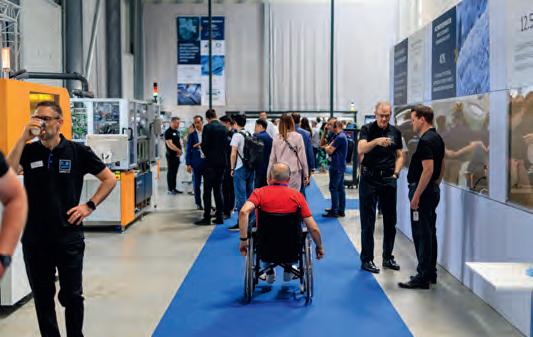
Attendees took a VIP tour of the Hockenheimring, with teams competing against each other in electric cars driving round an obstacle course, and seeing who could change Formula 1 racing car tires in the shortest possible time. Just like in the production, everything here was loud and fast, but adrenaline levels were certainly higher driving round the race track than when operating a generator in the lab. A fitting and successful finale to the event! Many participants are already waiting eagerly to hear when and where the next SLUGFest will take place. ◆
 F.l.t.r.: Tobias Gelada, Andy Huthoefer and Michael Kreis from Satisloh and Denis Gehrig (SCL) in front of Gleiberg Castle. Picture: Hanna Diewald
The machines were presented in an adjacent hall. Picture: Satisloh
One could see how humans and machines interact in many places. Picture: Satisloh
F.l.t.r.: Tobias Gelada, Andy Huthoefer and Michael Kreis from Satisloh and Denis Gehrig (SCL) in front of Gleiberg Castle. Picture: Hanna Diewald
The machines were presented in an adjacent hall. Picture: Satisloh
One could see how humans and machines interact in many places. Picture: Satisloh
MAFO 4-23 13 MAFO LIVE ON SITE
The participants listened attentively. Picture: Satisloh
AI and machine learning algorithms
Artificial intelligence (AI) is revolutionizing numerous industries, and there are numerous approaches to design these algorithms. How can these technologies be implemented in the design of progressive freeform lenses?
 By Gaetano Volpe and Pasquale Fanelli
By Gaetano Volpe and Pasquale Fanelli
In today's rapidly evolving technological landscape, AI has become an integral part of our daily lives. In recent years, this technology has been implemented in smartphones, voice assistants, in customized search results of popular streaming platforms, in social networks and so forth. But what exactly is AI?
Background
The term AI refers to the machines ability to perform tasks that typically require human intelligence, such as visual perception, speech recognition, decision-making, and language translation. To make these technologies work, it is necessary to “teach” machines how to perform these tasks successfully, through developing specific algorithms: this process is called machine learning and is a subset of AI research. As we explore the world of machine learning, one might wonder: what are the most used algorithms for programming AI software? What strategies are they based on? What is the role of AI in the design of progressive ophthalmic lenses? Is an AI revolution taking place, as in many other sectors?
This article aims to provide a general overview of the main types of machine learning algorithms, including “supervised learning ” , “u nsupervised learning ” , “reinforcement learning ”, and “multitask
learning”, and aims to propose a use scenario in progressive addition lenses (PAL) engineering.
Supervised learning
Supervised learning is a type of machine learning where the algorithm is trained on a labelled dataset, which means that the input data is paired with the correct output. In simpler terms, the programmer provides the algorithm with both the source information (input) and the precise result to be obtained (output) like a teacher guiding a student through a learning process. The teacher provides the student with examples of inputs and their corresponding correct outputs, allowing the student to learn the relationship between the two. The algorithm's goal is to learn the correlation from inputs information to outputs one, allowing it to make predictions on new, unseen data. Supervised learning is widely used in various applications, such as image recognition, speech recognition, and natural language processing. For example, in image recognition, a supervised learning algorithm might be trained on a series of images (dataset) labelled as either “cat” or “dog”. After learning the features that distinguish cats from dogs, the algorithm can then classify new, unlabelled images as either cats or dogs.
Data Handling & Security
MAFO 4-23 14 TECHNOLOGY
Unsupervised learning
Unlike supervised learning, unsupervised learning algorithms work with unlabelled dataset, meaning that the input data does not have any associated output. To put it simply, unsupervised learning is like a student looking for connections between information while studying a new subject, without any guidance from a teacher.
The goal of unsupervised learning is to discover hidden patterns or structures within the data. This type of learning is particularly useful for tasks such as: grouping similar data together based on their inherent characteristics or patterns (called clustering); or identifying errors, unusual patterns, rare events in a dataset (called anomaly detection).
An example of employing this type of algorithm might be a company that trying to group customers according to purchasing behavior. Imagine a dataset containing rough information about customers' shopping habits: an unsupervised learning algorithm could search patterns in this dataset to group customers with similar purchasing behaviors, allowing businesses to tailor their marketing strategies accordingly. It isn’t appropriate to use a supervised algorithm in this case as we don't know the purchasing groups' characteristics (output) when starting the analysis.
Reinforcement learning
Reinforcement learning is a type of machine learning where a decision-maker software (called agent) learns to make decisions by interacting with a controlled environment. Think of reinforcement learning as a trial-anderror process, where the agent learns from its experiences and it adjusts its choices accordingly, improving its decision-making skills.

One way to structure this type of algorithm is to design a reward system: the agent will be rewarded in the case of a correct answer and will receive a penalty in the case of a wrong answer. His task is to maximize the reward.
A classic example of reinforcement learning is teaching a robot to navigate through a maze (Fig. 1). The robot receives a reward for reaching the goal and a penalty for hitting a wall or taking too long. Over time, the robot learns the optimal path to exit the maze by maximizing its cumulative reward. Reinforcement learning has been successfully applied to various domains, such as robotics, game playing, and recommendation systems.
Multitask learning
Multitask learning is a machine learning approach where a single model is trained to perform multiple tasks simultaneously. Imagine a student studying multiple subjects at once, leveraging the knowledge gained in one subject to improve their understanding of another. The idea behind multitask learning is that the model can leverage shared knowledge across tasks, leading to improved performance and generalization.
For example, a multitask learning model could be trained on this two tasks: edge detection and shape recognition. The model can use the information gained in each assignment to improve the performance in both tasks. This approach has been applied to various domains, such as computer vision, natural language processing, and drug discovery.
Neural networks
Most of these techniques leverage a software framework called neural network also known as Artificial Neural Networks (ANNs). The neural network model is inspired by the functioning of biological brain networks. In fact, in the brain each neuron cell has an input and output signal, and all signals are aggregated according to their strength. Similarly, in ANNs each neuron or “node” takes an input and generates an output, and the outputs of all nodes are computed based on a property called “weight”, that represent the importance of the single node.
Using this model, one can easily increase the operation complexity at each layer of neurons, solving very complex tasks otherwise unsolvable with linear classical algorithms, just as it happens in our brain.
In the visual cerebral cortex, in fact, many simple neuronal cells are all connected to a complex cell, which computes their information based on their strength. Many complex cells are then connected to one hyper-complex cell, creating a hierarchical structure with levels that increases the complexity of visual processing at each step (like an upside-down tree).
When the number of hierarchical levels and the amount of initial information (dataset) increases significantly, the algorithm is called “deep neural networks” (or deep learning). Thanks to these characteristics, deep neural networks have achieved extraordinary accurate results in image classification, object detection, speech recognition, natural language processing, and more.
Machine learning algorithms in progressive freeform design optimization
Progressive freeform ophthalmic lenses are designed to provide a seamless transition between different focal lengths, offering clear vision at all distances for individuals with presbyopia. The production of a high-quality progressive lens requires a complex mathematical designing phase, where the lens surface is optimized to minimize optical aberrations and maximize visual performance.
Machine learning algorithms, particularly supervised learning, could be employed to model the complex relationship between lens parameters and visual performance.
Data Handling & Security
Fig. 1: Classical example of reinforcement learning.
MAFO 4-23 15 TECHNOLOGY
A critical aspect linked to progressive lenses is the final perception of the patient, as it cannot be measured.
Over the years of progressive designs development, satisfaction questionnaires were used by companies and researchers in which the end-user was asked to rate the degree of comfort at different viewing distances (example: far, intermediate, distance) on a numerical scale. Using this data, companies were able to identify the best designs and understand where to improve, but the process was time consuming and manual.
The volume of data collected from the questionnaires can be used, coupled with the lens design parameters (optical power, mounting and position of ware parameters), as an input dataset. This dataset can then be implemented in a neural network and the network can be trained to predict customer satisfaction from the input data. The questionnaire outcome, representing the wearer's satisfaction, is the output data of this neural network.
Furthermore, this type of neural network can be used to optimize some of the input parameters, thus improving the lens design as well. The algorithm tries to adjust the input parameters to maximize the output (client satisfaction) in a supervised environment. If the collection of feedback from customers continues, the network can keep learning over time and improve its predictions, also improving the efficiency in optimizing design parameters.
This neural network is schematized in figure 2, in which you can distinguish the input dataset (manufacturing parameters) and the output (result of the questionnaires). Hidden level features the trial-and-error mathematical algorithms that aim to maximize the outcome.
Conclusion
We explored the fundamental concepts behind artificial intelligence and the key types of machine learning strategies. This provides an idea of the structure of these complex algorithms and how it is possible to
train a machine to perform typically human tasks such as image recognition, speech recognition, natural language processing and so on.
Artificial neural networks are structured on the lines of biological ones and, combined with some of the learning models mentioned above, are widely used in the creation of AI tools. When the neural network becomes complex, with many layers of neurons and large datasets, one speaks of a deep neural network and the software can perform very complex tasks with greater accuracy.

Although there are no publications in the scientific literature on the application of these technologies in freeform lens design, we proposed a use case scenario.
This AI model, after being properly trained, can improve lens power map by changing the design parameters and automatically check in which cases you have the highest satisfaction score from the questionnaire (output). ◆
References:
Bishop, C. M. (2006). Pattern Recognition and Machine Learning. Springer. Hinton, G. E., & Salakhutdinov, R. R. (2006). Reducing the dimensionality of data with neural networks. Science, 313(5786), 504-507.
Sutton, R. S., & Barto, A. G. (2018). Reinforcement Learning: An Introduction. MIT Press.
Caruana, R. (1997). Multitask Learning. Machine Learning, 28(1), 41-75.
Gaetano Volpe is a computer and automation engineer. He’s a cofounder and head of research & development at ProCrea Tech. He’s pursuing a Ph.D. in electrical and information engineering with the Polytechnic University of Bari. Volpe has a long-time experience in optimization algorithms and lens design.

Pasquale Fanelli is an optometrist from the University of Salento. He works as a lens design specialist at ProCrea Tech and practices as an optometrist. His fields of interest are freeform ophthalmic lenses, specialized contact lenses and visual perception.

Data Handling & Security
Fig. 2: Schematic diagram of the neural network algorithm proposed to optimize a progressive power map.
Pasquale Fanelli
Gaetano Volpe
MAFO 4-23 16 TECHNOLOGY
cdc 500







The automated CDC 500 is one of SCL’s most reliable hard coating machines. Producing 60 lenses/h, it’s a perfect fit for small to medium size labs. It features six cleaning tanks and offers continuous and fast processing without any batching. Varnishing takes place by thermal polymerization. An automatic refill system provides consistent and stable process control - keeping detergent and varnish tanks at the same level and condition. A unique water cascading and filtrating system enables city water savings up to 75%, making the CDC 500 an environmentally-friendly coater.



Technique. Safety. Expertise. www.scl-intl.com HARD COAT LEADER
Hard coating at best price-performance ratio.
HARD COAT CLEAningTinTing PERiPHERALs COnsumAbLEs ExPERTisE
The new algorithm of lens development
Designing a spectacle lens is a highly complex science, now more than ever, and it is based on thousands of measured values and research results: increasingly detailed refraction, centering values, changing visual behavior due to digital devices, frame shapes, age-specific facial anatomy, pupil sizes and eye age. With the latest version of the Zeiss SmartLife portfolio (available since 2023), the company has succeeded in developing an algorithm based on these data volumes that combines “big data“ with subjective and objective measurement results – and thus lays the foundation for even more individualized lenses.
By Manuela Weinreich
Optical spectacle lenses have a history of more than 1,000 years of development. Since Abu Ali al-Hasan ibn al-Haitham, Alhazen in short, described the optical effect of curved lenses and ground magnifying glasses in the 11th century, we have seen countless innovations and milestones over the centuries that have made spectacle lenses better and better and correction options more and more individual. Today’s development and manufacturing of modern eyeglass lenses at Zeiss is based on four pillars:
1. K now-how about vision needs and visual behavior: consideration of visual behavior for the desired visual need and the intended use of the lens.
2. K nowledge about age-specific visual needs: consideration of visual needs in relation to anatomical and physiological changes, differences in lifestyle and habituation of the eyeglass wearer according to date of birth and age.
3. O ptical know-how about the lens-eye-system: consideration of the interaction between lens and eye and its impact on the calculation and manufacture of lenses for the desired optical performance.
4. Know-how to optimize the aesthetics of the eyeglass lens: consideration of the interaction of the physical appearance of the lens and its optical performance.
The focus is not only on progressive lenses – which are known to place the highest demands on the production of spectacle lenses for many reasons. Lenses for young people are becoming more complex, they are changing and need to be adapted to our changing visual habits, as the latest developments show.

It is all about preventing high-grade myopia in young people, and new solutions for vision are currently groundbreaking. Finally, it is important to counter the “pandemic of progressive myopia,” especially in China. In brief: for the manufacturing of individual spectacle lenses, it is enormously important to understand our vision behavior and our lifestyle habits better and better in order to be able to offer products that enable better, clearer and also healthier vision — and are no longer based purely on statistics and standard parameters or on a “one size fits all” approach. As trivial as this may sound, it is in fact complex. After all, the basis of the latest vision research is “big data”. There has never been so much data about every single person in this world and

Data Handling & Security
MAFO 4-23 18 TECHNOLOGY
How “big data” and recent scientific findings led to the highest level of personalization available in a Zeiss lens
the specific visual requirements of entire population groups and age groups as there is today. Zeiss makes use of this data, structuring and analyzing it in order to understand human vision better and better. As a result, the range of increasingly sophisticated, more individualized lenses is growing.


A case study of the individualization of a lens
Zeiss launched a completely new portfolio of premium lenses in 2018, named Zeiss SmartLife. The portfolio ranges from single vision to digital and progressive lenses. It is based on numerous technologies that are in place to ensure that those spectacle lenses (depending on the level) offer everything a modern lens must offer: refraction and centering values, consideration of the individual’s main activities, facial anatomy, frame shapes, consideration of individual habituation and the age-specific pupil dynamic and size.
In addition, the company has succeeded for the first time in incorporating data on actual viewing behavior across an entire portfolio into the lens design. The new portfolio is thus adapted to our mobile lifestyle, which is primarily characterized by the use of smartphones and tablets. But the special lens is even more: it is adaptive. This means that more and more knowledge about human vision is being incorporated into the lens design, resulting in increasingly individualized lenses for all age groups. The decisive factor here is that the complexity of the design is not at the expense of the partner eye care professionals. They get an improved and more individual product at hand but the consultation process, the fitting or even the ordering process does not change, everything remains as before.
Study situation
Let us take a closer look at the large data pool that provided important new knowledge for Zeiss SmartLife. Over a period of more than two years, the company has collected more than twelve million data records from eyeglass wearers, more than ever before.
The starting point was an online study that collected subjective data on the lifestyle of more than 300,000 consumers worldwide, and objectively measured data obtained with the help of a tracking procedure on viewing behavior. Both data pools were incorporated into the Zeiss Global Vision Study [1] of 2020/21.
In tracking visual behavior, millions of objectively measured data points were collected from the daily lives of several hundred individuals from the U.S., China, and Germany. The subjects were from various occupational groups with different social and cultural backgrounds and ranged in age from 21 to 80 years.
They were then divided into six age groups (21-30 years, 31-40 years, 41-50 years, 51-60 years, 61-70 years, 71-80 years). The study examined how these people see in everyday life, what visual demands they have at work, at home or in their leisure time and was thus able to provide researches with conclusions about their actual visual behavior.
Among other things, the study showed that the visual demands in the six age groups differ significantly from one another – in the sense
Fig. 1: Illustration of how interaction with digital devices has increased regardless of age. Age-dependent commonalities were identified in the usage patterns, making it possible to delve deeper into the age structure and filter out age-specific details that make a difference. For illustrative purposes, these were divided into age groups.
of age-related differences in dynamics and in activity-dependent visual behavior.
It found that there is a difference between biological age and the socalled eye age, the optometric status of the eye (the actual visual acuity and habituation of the eyeglass wearer).
This information was added to the already known data from various studies on visual requirements, and based on this entire pool of data, an algorithm was developed to predict the visual behavior and thus the required lens design for the eyeglass wearer. This assumption has been transferred as the basis for the new design of Zeiss SmartLife.
More data, more possibilities
More individual data and parameters about the visual needs and behavior of eyeglass wearers allow for more possibilities and even more specific vision solutions for the individual. Nowadays it’s crucial to make use of these large and complex volumes of data by converting it into a large number of possible target designs.
While there were only a few hundred designs in the first generation of Zeiss SmartLife Individual, there are already more than forty thousand in Zeiss SmartLife Individual 3, which serve as the basis for the final lens. This is made possible by the use of the Zeiss Intelligence Augmented Design (IAD) algorithm. It uses all of the customer's data transmitted by the eye care professional, i.e. the specified lens type, individual prescription, frame data and age, and compares this data with the vision requirement profiles in the database in order to select the optimum design target. In a final step, all the customer's individual parameters are then used in an optimization process to adapt the lens to be manufactured as closely as possible to the optimal target design.
Data Handling & Security
MAFO 4-23 19 TECHNOLOGY
For illustration purposes: Let's take a 65-year-old eyeglasses wearer who is to be fitted with a Zeiss SmartLife Individual 3 progressive lens. To calculate the lens, the IAD algorithm requires the date of birth in addition to all order parameters.

This data is enriched with the large data pool, the biological age is compared with the eye age (based on the ordered addition) and the target design is calculated from this, resulting in the best possible individualized visual comfort for that 65-year-old.
This means that even if two customers of different ages have the same prescription, they will receive a lens design that is optimally matched to their visual needs, considering their individual visual habits and parameters.
In numbers that means: the optical performance of the new Zeiss SmartLife Individual 3 lenses is up to 29% better compared to previous SmartLife Individual lenses. In addition, 85% of wearers perceived wide fields of comfortable vision in all directions and at all distances [1]
Further study layers crucial for today's vision
New vision parameters have been incorporated into the large data pool for the new generation of all Zeiss SmartLife lenses. For example, the Zeiss Vision Science Lab at the University of Tübingen has researched the eye’s center of rotation.
Since the development of the eye model by Allvar Gullstrand (1911), one center of rotation has been assumed for all rotational movements of the eye based on prescription values. However, the study showed that the location of the rotation axis for vertical eye movements is significantly different from that for horizontal movements. The approach of the new SmartLife portfolio is primarily to take into account the changing visual behavior in today's smart and connected world and the increasingly dynamic vision with the many changes of gaze and “seeing out of the corner of the eye”, i.e. the increased need for peripheral vision.
Therefore, knowledge of the position of the horizontal and vertical eye rotation axis is particularly valuable in minimizing aberrations for the gazing eye when looking obliquely/peripherally through the lens. This is also shown by the investigations in our laboratories, in which we have determined corresponding limit values for determining the visual
range sizes and compared them with previous designs. This results in larger visual ranges for the new generation of Zeiss SmartLife lenses for the distance range than for the previous lenses and the digital and progressive lenses now also have larger visual ranges for looking at smartphones than for the previous SmartLife counterparts.
Conclusion: why spectacle lenses must always become more individualized

Over the past decade, refractive techniques, manufacturing processes, optical designs and consumer demands for lens performance have changed significantly. The flexibility, individuality and spontaneous tolerance of lenses is greater today than ever before.
Technology and personal needs, visual comfort and preferences, fashion trends, digitalization and big data continue to drive development. Although amazing strides have been made, for Zeiss this is only one step in the journey towards even more individualized lenses. ◆
References:
[1] Market consumer acceptance test on Zeiss SmartLife Individual 3 lens portfolio with n=172 study participants in DE, IT, CN by Carl Zeiss Vision International GmbH, DE 2022. (unpublished, data on file)
Manuela Weinreich has been working for Zeiss Vision Care as global product manager since 2009. Her official title is Head of Global Product Management Lens Designs. Accordingly, she is responsible for product management of the entire global VIS lens design portfolio. Weinreich is a qualified eye care professional with a degree in ophthalmic optics (Dipl. Ing.) from HTW Aalen (2005). She worked as an eye care professional for a while before joining Zeiss.
Data Handling & Security
Manuela Weinreich
MAFO 4-23 20 TECHNOLOGY
Fig. 2: Schematic representation of the improved distribution of the visual zones in Zeiss SmartLife Individual 3 lenses, adapted to individual visual behavior.
ChatGPT definition
Chat GPT, short for “Chatbot Generative Pre-trained Transformer,” is a new form of natural language processing. It is quickly gaining traction in the tech industry because it can simplify complex tasks. The AI program autonomously creates any text you want. All it takes is typing a question and you get an answer in seconds. The use is free of charge. Because of this, the number of users has already exploded in a short time. Students use it for essays, businesses use it for their administration, and it is even capable of writing poetry. The possibilities seem endless.
ChatGPT and real-time data
However, there is also criticism of the chatbot. For example, the widely used free version of ChatGPT is based on pretrained data (until year 2021), it cannot process information in real time. In simpler terms, ChatGPT has read an old book and can only give answers based on the information in that book. This is now to change with the new version. GPT-4 is able to analyze and convey current information. However, the new version is currently not available for free.

Employees attempting to use ChatGPT at work
According to Statista, as of June 2023, it was reported that 10.8% of employees of worldwide companies have tried using ChatGPT in the workplace at least once. Those who have put confidential corporate data into the AI-powered tool were 4.7%.
ChatGPT in enterprises
Five facts
ChatGPT has experienced immense hype after its release in 2022 and as employees are also using the new chatbot in companies, MAFO has summarized the most important facts every team leader should know.
Global cases of sensitive data spill into ChatGPT 2023
According to Statista, between the 9 th and 15th of April 2023, per 100,000 employees, 319 cases of sensitive data leaking on ChatGPT were spotted in worldwide companies. Compared to an observation between February and March 2023, the figure had increased by around 60%. The second-most common type of confidential data shared on ChatGPT was source code, with 278 cases per 100,000 employees.
Familiarity with ChatGPT in the U.S. 2023, by education
According to Statista, adults with the highest education level - particularly with a postgraduate degree - had the greatest level of familiarity with ChatGPT. The program, developed by startup OpenAI, was of far less concern to those with high school degrees or lower education. When looking at respondents with a little knowledge of ChatGPT, the numbers are far less drastically different. It is quite likely that the considerable coverage of the ChatGPT topic in media had an impact, giving most people some awareness of the topic. ◆
Data Handling & Security
MAFO 4-23 21 TECHNOLOGY
PFAS – what we know and what we do not know yet
Interview with Spectaris
PFAS are a group of chemicals comprising a very large number of substances. The number is estimated at approximately 10,000. Due to their special properties, the substances have been widely used for a long time in many industrial sectors and also in the household. However, many PFAS are toxic, accumulate through the food chain or are mobile and once released into the environment they are difficult or impossible to remove. Therefore, a ban is under discussion that could also affect spectacle lenses. MAFO has talked to Spectaris (German industry association for optics, photonics, analytical and medical technologies) about the current situation.
By Hanna Diewald
Which products, in the ophthalmic industry, do contain PFAS?
To answer this question, some background is necessary: Denmark, Germany, the Netherlands, Norway and Sweden have submitted a proposal to restrict the use of per- and polyfluoroalkyl substances (PFAS), with some use-specific, time-limited exemptions based on the availability and applicability of alternatives.
The proposed PFAS restrictions are the subject of study and extensive debate affecting numerous products, including medical devices, which include ophthalmic products.
All manufacturing companies are currently required to evaluate the extent to which their products contain one or more of the 10,000 substances. These tests are in full swing.
Since optical medical devices, which include frames, lenses and contact lenses, represent a wide range of materials, it is not possible to give a definitive answer to such a question at this time. To the best of our knowledge, ophthalmic lenses and contact lenses are most likely to be affected. The PFAS in high-performance materials will be the political undoing of precisely the technical property because of which they are used and are predominantly irreplaceable: their durability and resistance in industrial high-tech products, essential applications in medical technology and, of course, in ophthalmic optics products.
One thing is clear: if PFAS are present in products, it will most likely be difficult to replace them and still be able to manufacture medical products of the same high quality.
PFAS are said to be contained in coatings for spectacle lenses. Can you already say, at this stage, in which part of the coating exactly are PFAS usually used?

Modern premium spectacle lenses, such as those manufactured in Europe, are characterized by their optical performance, individual correction, as well as their long life and convenient use. Scratch resistant coatings, easy-to-clean-, and anti-reflective coatings contribute significantly to this. Modern premium lenses therefore contain PFAS in extremely small quantities.
These top coating layers provide dirt-repellent and easy cleaning properties. These coatings significantly increase the service life of spectacle lenses, which are subject to a great deal of wear and tear in everyday use due to dust, dirt and cleaning.
This is not only a matter of convenient cleaning and thus convenience for spectacle wearers, but also a matter of safety: clean and scratchresistant lenses enable the best possible vision, especially in safetyrelevant situations such as driving, in road traffic.
MAFO 4-23 22 SPOTLIGHT
Are there coated lenses that do not contain PFAS at all?

In principle, yes, but they do not have the advantages mentioned. The service life of such lenses is dramatically shorter. The quality of vision and the associated main function of the lenses is also severely impaired.
The vast majority of all premium lenses sold in Europe are equipped with high-performance coatings – a clear added value for customers and patients and a competitive advantage over no-name or low-cost suppliers from Asia.
Can you currently estimate exactly what impact a ban on all PFAS could have on the ophthalmic lens industry?

Currently, there are no known alternatives with comparable properties. With considerable effort and lead time, these could possibly be developed. In the short and medium term, however, a PFAS ban would reduce an important competitive advantage of European quality manufacturers and consumers would probably switch to cheap products from non-European production.
A shorter service life – due to higher stress on the lens surfaces from dust, dirt, cosmetic and other substances that are less easily removed – leads to the need to replace spectacle lenses more frequently, with the associated increased consumption of resources.
What can and should affected manufacturers do now?

Manufacturers support the move away from substances that are hazardous to the environment and people, and are making corresponding avoidance and substitution efforts to this end as part of their sustainability strategies. Specifically, they are working to develop substitutes for PFAS currently in use – wherever this is technically possible and feasible with reasonable timeframes to develop and industrially scale up substitutes.

As industry representatives, we are also committed to ensuring that the idea of the “essential use” concept is taken into account. This provides for blanket exemptions for essential areas of life as well as high-tech applications, including medical devices. In addition, the use of PFAS-containing intermediates, process aids and plant components in industrial plants must remain possible.
In addition, due to the sheer quantity of indispensable PFAS for essential applications, broader exemptions should be defined on the basis of suitable substance groups (“PFAS of low concern”) that have already been scientifically proven to be harmless, i.e. non-toxic. An indefinite exemption for fluoropolymers and fluoroelastomers should be considered. ◆
Advertisement WATCH VIDEO MAFO 4-23
Anything but ordinary Transitions Academy 2023
It is going to be exciting. Basically, that was clear the moment the invitation to attend the 26 th Transitions Academy in Orlando, Florida, arrived. On May 22 and 23, 1000 ECPs from more than 50 different countries made the pilgrimage to the JR Marriot Grand Lakes Hotel, where exciting topics, product innovations and immense networking potential awaited the visitors. By Sarah
Schmidt
It is 8 a.m. on May 22, 2023, and the 1,000 Transitions Academy attendees are gathering in the hotel´s massive ballroom for the official opening of the event. Under the motto “Lights on Tomorrow,” innovations are presented and new i mpulses are set.


The focus, of course, is on Transitions lenses, which are now available in seven brilliant colors. From hip amethyst purple to sapphire blue and classic brown, there is a color available for everyone. This new variety gives the entire Transitions lens technology an image makeover, and now appeals to the fashion-conscious and especially the young buyer base who may not have heard of light-changing lenses before.
Colors accompany us everywhere
When we are in love, we literally wear rose-colored glasses or we can get green with envy – colors accompany us through our lives as a matter of course, often unconsciously exerting a major influence on our
everyday lives. This is exactly where EssilorLuxottica´s future projects come in. Work is currently underway on spectacle lenses that are designed to intervene directly in the health and well-being of eyeglass wearers through certain tints. Light therapy is already being used to alleviate patients´ symptoms in the case of certain diagnoses, such as migraines or depression. A corresponding spectacle lens could follow up on this approach and help to cope better in everyday life.
Cooperation with Ray-Ban
Another news is the cooperation with Ray-Ban X Transitions, where Ray-Ban frames are increasingly offered with Transitions lenses. Furthermore, a small collection is being worked on, in which not only the lenses, but also the frame changes in the sunlight. The first prototypes, which were presented despite the early stage of development, show a light-changing pattern on the frame edges – but of course a change of the complete frame color would also be conceivable.
MAFO 4-23 24
SPOTLIGHT
An entertaining program
After the comprehensive opening lecture, the participants split up into different groups to take part in smaller workshops, the so-called breakout sessions. In this way, topics such as the psychology of colors, the customer journey or the connections between vision and light were revisited. In the so-called “Brand Experience”, the Transitions brand was brought to life once again, with fun and entertainment provided by a photo wall that generated funny avatars of the visitors thanks to whimsical filters, or the opportunity to play various games using VR glasses. The technical highlight of this Brand Experience was the presentation of motorcycle helmets whose visors adapt to the light conditions thanks to Transitions technology.
The keynote presentations were given by well-known speakers from various industries and sectors. Shawn Kanungo, for example, spoke about artificial intelligence, how it is already being used today and what possibilities are conceivable in the future.
After an eventful conference program, various ways were used to ensure an entertaining evening for the participants. Whether a joint dinner or an evening in a karting hall – there was probably something for every interest group.
Charming speakers and vibrant music on day 2
The second day started with a lot of excitement – as the opening speech was not only introduced by the charming presenter Miriam Isa, but a band attracted the participants to the great ballroom at the morning hour.
Then a panel of experts, consisting of various members of the EssilorLuxottica team and opticians and optometrists, settled on the stage to share their experiences around Transitions lenses.

One of the optometrists fitted professional swimmer Yohann Ndoye-Brouard with Transitions lenses in his swimming goggles, which enabled him to improve his performance immensely. From these stories, it was clear that Transitions lenses are capable of positively
TOOLS


impacting the vision and, in turn, the lives of consumers. Another block of breakout sessions was followed by the inspiring final key note presentation of Michelle Poler, famous as „fear-facer“.
Poler has created a social movement empowering millions to step outside of their comfort zone and tap into their full potential. In her presentation she described her personal journey from being a “scaredy-cat” to becoming a courageous power woman who faced her fears and successfully overcame them to rise above herself and fulfill her desires.
Innovation Awards
Following this presentation, the Transitions Academy Innovation Awards were presented in various categories, such as US Retailer of the Year or Canada Retailer of the Year.
After this ceremonial act, the participants moved on to the final program item of the conference schedule. Countless shuttle buses took the 1,000 participants to Mango´s Tropical Café in downtown Orlando for the closing event. In this bar not only a delicious buffet was waiting for the participants of the Transitions Academy, but also a terrific band, which provided for high spirits. There was dancing, laughing and celebrating a

SPOTLIGHT REDEFINING THE EDGE ULTRA PRECISION DIAMOND
ky diamond.ca • Diamond tools for any generator • Excellent service • Quick turnaround
Expert panel with various ECP´s.
Combination treatment in myopia management
When do Miyosmart and low-dose atropine complement one another?
A few years ago, Hoya Vision Care introduced the Miyosmart spectacle lens, at this time the first noninvasive method to slow down myopia progression in children with defocus segment technology. Additionally, experts use either special contact lenses, multifocal spectacle lenses or atropine eye drops for myopia management in children. The obvious question is whether the different approaches can be successfully combined. With initial studies showing promising results, Hoya Vision Care is now investigating with global experts when is the ideal time to prescribe atropine for patients with severe myopia progression.
Almost immediately after the market launch of Miyosmart in Germany, ophthalmologists and orthoptists began to wonder what a combination of special specatcle lenses and atropine might achieve, particularly in patients with severe myopia progression. At that time, there were no data on this, but now clinical evidence is available.
Miyosmart with DIMS (Defocus Incorporated Multiple Segments) Technology first became available in Germany in March 2021, and
since then Hoya Vision Care has been working with experts from around the world to build up an evidence-based foundation and consensus on how ophthalmologists might best combine the use of those spectacle lenses with atropine.
Great interest in spectacle lenses
“Spectacle lenses offer an opportunity for safe, non-invasive and effective myopia management in children and teens,” said Torben Othersen, Professional Affairs Manager for myopia at Hoya Lens

MAFO 4-23 26 SPOTLIGHT
Germany. “Since the Miyosmart spectacle lenses became available in Germany, there has been a very high level of interest in intelligent myopia management for children using Miyosmart; both on the part of ophthalmology and orthoptics as well as optometry. We are very pleased about it, because the interdisciplinary exchange between eye care professionals is enormously important for any serious and sustained discussion of myopia management,” adds Othersen.
Confidence in the special spectacle lenses by eye care professionals has been further reinforced following publication of the 6-year results from the long-term clinical study in April 2023, showing that these lenses remain effective over a long period of time.[1] This is the longest study on spectacle lenses for myopia management ever carried out.
The 6-year results are follow-up on the 2-year double-blind randomized controlled clinical trial (RCT) published in the British Journal of Ophthalmology in 2019.[2]
Results from this study indicate that the children aged 8 to 13 who received Miyosmart spectacle lenses from the beginning demonstrated a slowdown on average by 60% in axial eye length growth and on average by 59% in refractive error progression, compared to the control group who wore conventional single vision spectacle lenses during the first two year of the study.[2]
After the Miyosmart spectacle lens was able to establish itself globally, with over four million lenses already sold in Asia, Australia, Canada and Europe from launch in 2018 up to the end of 2022, [3] Othersen says: “It was appropriate for Hoya Vision Care to initiate a discussion about a combination treatment with low-dose atropine. Thus, Hoya convened a meeting with global experts in 2022, with the aim of finding a consensus on how the use of atropine could best be combined with these spectacle lenses.”
Experts from around the world
The participants included renowned experts from Europe and Asia, among them was the respected myopia researcher Professor Hakan Kaymak from Düsseldorf, Germany, who shared with the expert´s insights from his clinical experience and research.
All experts as well shared their experience with Miyosmart spectacle lenses, including their clinical use in combination with 0.01% atropine in myopic children and adolescents in Europe, when the desired results were not achieved with using Miyosmart spectacle lenses as a monotherapy.
Key findings
The experts noted a “better control effect” with the combination treatment and reported that there were no clinically significant differences in visual acuity, contrast vision or binocular vision depending on whether Miyosmart spectacle lenses were used alone or in combination with low-dose atropine. According to Othersen, the consensus helps ophthalmologists to distinguish whether a patient
should continue having a monotherapy or whether a greater myopia control effect could be achieved through the combination of spectacle lenses with low-dose atropine.
“This largely depends on whether the treatment goal has been achieved in the patient or not. If myopia progresses at the rate of emmetropic eye growth, continuation of a monotherapy with Miyosmart spectacle lenses is recommended,” Othersen explained. “However, when the treatment goal has not been achieved, it is important to inform eye care professionals about the additional benefit of combination treatment with low-dose atropine. Both procedures offer different approaches to slow down fast myopia progression; as such they are complementary.”
Treatment goals and geographical differences
Much of the discussion concerned the question of whether the treatment goal has been achieved or not. But what is the goal in myopia management? Led by Prof. Kaymak, the five experts pointed out that while the approach of using emmetropic respectively physiologic eye-length growth as a guide to myopia progression has been described in several papers, it has not been fully accepted yet.
However, eye growth in axial length of 0.10 mm per year between the ages of 10 and 13 has been shown to be associated with normal emmetropic eye growth,[4] whereas eye growth of more than 0.20 mm per year indicates that the treatment goal has not been achieved. Here it is important to mention that emmetropic eye growth is age-dependent. A Dutch study found that annual eye growth averaged 0.09 mm in 10- to 13-year-old emmetropes and 0.19 mm on average in 6- to 9-year-old emmetropes.[5]
However, treatment goals may also vary depending on which part of the world is concerned. “Treatment goals in diopters differ in Asian and Caucasian children. In Asian children, an annual increase in refractive error of less than -0.80 D is considered successful. In Caucasian children, European experts recommend a threshold of -0.50 D or less per year,” experts say.
Regarding the start of treatment, the expert panel recommended that older children with a lower risk of developing severe myopia, may initially be treated with optical interventions alone. In young children with a high-risk profile and myopia progression of -0.50 D or greater over the previous six months, starting immediately with combination treatment should be considered.
When the treatment goal has not been achieved, it is important to inform ECPs about the additional benefit of combination treatment with low-dose atropine.
MAFO 4-23 27 SPOTLIGHT
But what concentration of low-dose atropine is appropriate?
The experts explained that the dosage is usually set individually, depending on the myopia control and the side effects. They referred to the LAMP study which was conducted on Chinese children. The study evaluated the efficacy of different dosages of 0.01%, 0.025% and 0.05% over a three-year period. Dose-dependent efficacy for myopia control was observed, i.e. the higher the dosage, the better the myopia control. While side effects appeared acceptable at a dosage of 0.05% in Asian children, this was not the case in Caucasian children with lighter eyes.[6]
“The experts did not find clinically significant changes in visual acuity or binocular vision when comparing Miyosmart spectacle lenses as a monotherapy and in combination with low-dose atropine”, the consensus document states.

“Contrast vision with Miyosmart spectacle lenses alone and in combination with 0.01% atropine was investigated. No differences in contrast vision were found.[7] Where the expected treatment goal was not achieved with Miyosmart spectacle lenses alone as a monotherapy, the experts observed an improved myopia management effect using a combination treatment with low-dose atropine.” Another important consideration is variations in how atropine is prescribed in different parts of the world. Currently, atropine is prescribed in doses ranging from 0.01% to 0.5% for children in Asia.
However, this also depends on the individual country and the particular preferences of the eye care professionals concerned.
In some countries, reimbursement by health insurance companies also plays a role. In Taiwan, for example, only concentrations of 0.125% and higher are reimbursed, and thus these are more commonly prescribed than lower dosages.
In many European countries, where atropine is not reimbursed by the health insurance, the most common dosage is still 0.01%. However, the consensus of most professional ophthalmic associations now tends to be towards a higher dosage of 0.02% to 0.05%.
What studies show
In parallel with the consensus document, the investigations on combination treatment with spectacle lenses and atropine are growing.

In October 2022, Prof. Kaymak published his study examining the safety of combination treatment with Miyosmart spectacle lenses and 0.01% atropine.[7] In a pilot study of 12 young adults, he analyzed combination treatment in terms of safety. In each subject, bestcorrected visual acuity, contrast vision, and glare sensitivity were examined under the influence of the spectacle lenses alone and in combination with 0.01% atropine.
Miyosmart spectacle lenses with DIMS. technology do not pose any safety risk.[7] No significant changes were observed in visual acuity and binocular vision between Miyosmart spectacle lens alone and in combination with low-dose atropine.[8]
In an even more recent study, led by Zhu Huang et al. at Zhejiang University in Hangzhou, China, published in December 2022, the research team evaluated the efficacy of DIMS spectacle lenses in combination with 0.01% atropine. To the best of their knowledge, this study was the first to examine the treatment effect as a combination therapy with 0.01% atropine in terms of slowing axial eye length growth in myopic children.[9]
The retrospective study of 107 children was designed to determine whether combination treatment could slow the myopia progression, compared with a monotherapy or single vision spectacle lenses on their own.
Fig. 1: Model-adjusted mean and SE of myopia progression (SER) from baseline to 12 months.
Fig. 2: Model-adjusted mean and SE of change in axial length from baseline to 12 months.
MAFO 4-23 28 SPOTLIGHT
In young children with a high-risk profile and myopia progression of -0.50 D or greater, over six months, starting immediately with combination treatment should be considered.
“After the one-year follow-up period, the monotherapy with Miyosmart spectacle lens showed that myopia progression and axial eye length growth were lower compared to single vision spectacle lens use and even better in subjects treated with combination treatment with 0.01% atropine. This indicates a synergetic effect due to the combination treatment,” the authors report.
First European study on combination treatment [10]
The study, designed by Prof. Paolo Nucci and his team, was conducted with the aim to evaluate the efficacy of spectacle lenses with DIMS technology in slowing the myopia progression in young children and teenagers aged 6-18 years.
Subjects were treated with either 0.01% atropine, Miyosmart spectacle lenses, or a combination treatment using both, depending on patients and parents’ choice. The refractive and axial elongation changes of the three groups were then compared with a group of children wearing conventional single-vision spectacle lenses (control group).
Subjective visual acuity, cycloplegic refraction (SER), and axial length (AL) were assessed at 3, 6 and 12 months after the start of treatment. The analysis, performed on a total of 146 subjects, showed a reduction in the myopia progression in the three treatment groups, both in terms of change in refractive error and axial eye length growth. Among these, the group which received combination treatment showed an even more significant reduction in myopia progression. The results confirm the efficacy of low-dose atropine and of Miyosmart spectacle lens, as monotherapy in each case, in slowing myopia progression. The efficacy of both interventions is further increased when prescribed in combination.
with Haag-Streit to market the Biometer (Lenstar Myopia) for measuring axial eye length.
“More and more eye care professionals are realizing that they can use optical biometry to provide and ensure the gold standard for myopia management,” Othersen says: “The ability to take objective measurements, such as measuring eye length, is related to the consensus document and provides information on whether treatment goals are best met with Miyosmart spectacle lenses as a monotherapy or whether it should rather be combined with additional low-dose atropine,” concluded Othersen. ◆
This article was written in collaboration with Torben Othersen, Professional Affairs Manager Myopia at Hoya Lens Germany. The Master Optician has many years of experience with chain stores and traditional opticians. Most recently he worked as Key Account Manager Myopia Program in the Professional Service DACH division in the optical industry.
Raising standards
According to Othersen, in light of the emergence of new research and consensus on combination treatment, Hoya Vision Care aims to continue to play its leading role in myopia management and ensure that eye care professionals can make clear, informed decisions about evidence-based treatment for myopic children. This is part of a sustained effort to try and raise the standard of myopia management worldwide. It includes Hoya Vision Care's partnership
References:
[1] Lam, C.S.Y., Tang, W.C., Zhang, H.Y. et al. Long-term myopia control effect and safety in children wearing DIMS spectacle lenses for 6 years. Sci Rep 13, 5475 (2023). https:// doi.org/10.1038/s41598-023-32700-7
[2] Lam CSY, Tang WC, Tse DY, Lee RPK, Chun RKM, Hasegawa K, Qi H, Hatanaka T, To CH. Defocus Incorporated Multiple Segments (DIMS) spectacle lenses slow myopia progression: a 2-year randomized clinical trial. British Journal of Ophthalmology. Published Online First: 29 May 2019. doi: 10.1136/bjophthalmol-2018-313739
[3] Based on the number of lenses sold according to Hoya sales data (as of January 2023) (in German). Individual wearer’s results may vary.
[4] Gifford KL, et al. IMI – Clinical Management Guidelines Report. Invest Ophthalmol Vis Sci. 2019;60(3):M184-M203.
[5] Rationale for Intervention. MYOPIE.NL. Available from: https://www.myopie.nl/en/ professionals/rationale-for-intervention/ (Accessed 30. June 2023).
[6] Joachimsen L, Farassat N, Bleul T, Böhringer D, Lagrèze WA, Reich M. Side effects of topical atropine 0.05% compared to 0.01% for myopia control in German school children: a pilot study. Int Ophthalmol. 2021;41(6):2001-2008. doi:10.1007/ s10792-021-01755-8
[7] Kaymak H., Reliability of DIMS spectacle lenses and atropine in combination therapy to inhibit myopia progression (in German). Klin. Monatsbl. Augenheilkd. 2022; 239: 1197–1205.
[8] Kaymak H, et al. Safety of DIMS Spectacle Lenses and Atropine as Combination Therapy for Myopia Progression. Klin Monbl Augenheilkd. 2022,239(10):1197-1205.
[9] Huang, Z., Chen, XF., He, T. et al. Synergistic effects of defocus-incorporated multiple segments and atropine in slowing the progression of myopia. Sci Rep 12, 22311 (2022). https://doi.org/10.1038/s41598-022-25599-z
[10] Nucci P, Lembo A, Schiavetti I, Shah R, Edgar DF, Evans BJW. A comparison of myopia control in European children and adolescents with defocus incorporated multiple segments (DIMS) spectacles, atropine, and combined DIMS/atropine. PLoS One. 2023 Feb 16;18(2):e0281816. doi: 10.1371/journal.pone.0281816. PMID: 36795775; PMCID: PMC9934319.
Torben Othersen
The group which received combination treatment showed an even more significant reduction in myopia progression.
MAFO 4-23 29 SPOTLIGHT
Back to its roots
Leica Eyecare: a traditional brand returns to Germany

The first state-of-the-art Leica Eyecare production facility is being built in Heuchelheim near Wetzlar (Germany). “Starting from scratch” is the motto here because, for the first time in its history, the famous company is setting up its own spectacle-lens production. For CEO Jörg Bauer, this is like having a baby – his baby, to be precise. When asked why, he answers promptly: “Because Leica spectacle lenses have always belonged here.” So MAFO went on site to take a closer look at the new production facility. (Note: Mafo visited the production a few weeks before the official opening in July 2023). By Hanna Diewald
We are greeted by Jörg Bauer, CEO of Leica Eyecare, and Marketing Manager Claudia Rehm: “Welcome to Wetzlar, the City of Optics. There is no way we can withhold the Leica world from you.” What is behind this statement soon becomes clear. We are standing right in front of the company headquarters, which is clearly an architectural gem. The entire building is designed to resemble a camera and round the roof there is a path with a spectacular view of the surrounding area. This makes even more curious to find out what lies hidden within the building itself.
The Leica brand
Our tour starts in the photo exhibition area and at the same time allows us to catch a glimpse of the camera production. Behind a pane of glass sit highly focused employees painting the edges of lenses black. At another station, a camera is being assembled from hundreds of components – some of them tiny. Here, absolute silence reigns, everything is neat and tidy. The meticulousness with which the employees go about their work is almost infectious and making everyone in front of the glass want to hold their breath. There are hardly any machines. Everything seems perfectly
The inspiration for the architecture of the Leica head-quarter was a camera.
MAFO 4-23 30 MAFO LIVE ON SITE
Pictures: Silke Sage
attuned, running like clockwork. Every operation is performed by hand. So this is where the world-famous premium cameras are made. Besides the production and administration, the neighboring buildings house a museum and a hotel as well as an academy, where one can attend photography courses, for example. All in all, around 730 employees work at the site. However, the reason for the visit is not about the headquarters, of course, but about spectacle lenses. And there we are to dive into a completely different world.
Green-field production site
Our tour next takes us to the small town of Heuchelheim, about 15 minutes by car from the headquarters. Here, Leica Eyecare’s first purpose-built production hall has recently been erected – the contrast to the camera production could not have been starker.
A new, state-of-the-art lens production facility has been built here from nothing in just a few months. In contrast to our first stop, it is loud, lively, everything is fully automated and the machines are of the latest design. No need to whisper here.
The excitement of the managing director and the employees is palpable. No wonder, because in a few weeks, their “baby” will finally come to life. The first Leica spectacle lens production facility in Germany. But how did this come about, and why now?

The Leitz Camera

To understand Leica spectacle lenses better, it is worth taking a step back to look at the company’s history. Founded in the 19 th century as a family business, the company is now active worldwide. Under the founder Ernst Leitz, and later his son of the same name, the company became famous around the world.
The name Leica is a contraction of Leitz Ca mera. The company only entered the spectacle lens market in 2018. Novacel became the exclusive partner for the production and distribution of Leica Eyecare spectacle lenses in Europe. That the lenses were previously produced in France Jörg Bauer explains with the fact that the focus of the business at that time was simply elsewhere.
Sometimes the timing and the people have to fit perfectly – and that's exactly what’s happened now: “Maybe what was missing was someone
 Leica's origins lie in camera production, for which the company is world-famous.
CEO Jörg Bauer in the new production hall.
Cross-section of a camera lens.
Leica's origins lie in camera production, for which the company is world-famous.
CEO Jörg Bauer in the new production hall.
Cross-section of a camera lens.
MAFO 4-23 31 MAFO LIVE ON SITE
who had the energy to say, ‘We’re going to do this on our own here on site,’ who could work out a project and really convince the board. That's what I did in 2020,” Jörg Bauer explains.
Building up the company from scratch was a real challenge for the CEO. After all, it called for a motivated team, a viable concept and setting up production in a place where at the beginning of 2021 there had only been an empty warehouse. But he and the team made it happen.
Novacel will remain an important partner, especially for sales in other European markets: “I can't imagine a better partner for France, for example, where Novacel is number three in the market,” says Bauer.
State-of-the-art production
The excitement that has built up over the past few months to bring the baby to life is almost palpable; everyone seems highly motivated and enthusiastic. Right now, the final test spectacle lenses are still running on the production line.
There is always some detail that needs fine-tuning or a setscrew adjusted to make the end product – the lenses – just that little bit better. Currently, 20 employees work at the site. By the end of the year, the team is expected to grow to around 30 people.
From July 1, around 600 orders per day are to be produced. That is the initial volume planned, but it can then be increased relatively easily, for example by switching to 2- or 3-shifts a day.
Setting up such a production is a challenge: “There was nothing there to start with and everything has to be created. And it's not just about the production, it's about the entire supply chain. Everything has to run smoothly, from the interface with the customer to the development of the Super Clean Code, compliance with standards – such as the Medical Devices Regulation – to the toilet paper holder. That's when the team quickly has 15- to 16-hour days,” says the CEO as he describes the demands on himself and his employees.
But starting from scratch has many advantages, too, because there is no legacy from the past. There are dozens of machines in the hall. They are the latest available on the market. The majority of them come from manufacturers located in the immediate vicinity.
If the anti-reflective coating still needs optimizing or a process is not yet running perfectly, the experts in the companies concerned can be contacted easily and information exchanged. After all, the combined expertise of the ophthalmic optics industry is virtually on site.
And the machine manufacturers benefit, too, since they can also use the new production facility as a “show lab” for their customers – so it is a win-win situation.

Paperless production
Thanks to the well thought-out concept, the production is extremely energy efficient: “I think we've gone as far as you can go where it comes to sustainability,” Jörg Bauer proudly explains.
This also calls for genuine innovation, since the lab function is now entirely paperless: from the first operation, when the blank is removed from its packaging, to the last step, the final inspection.
In practice, this means that each pair of lenses and the tray have to be “married” up again several times.
After all, each lens has a long way to go through the 1500-square-meter hall. At no point during the various processes – grinding, polishing, cleaning, coating, tinting, final inspection and more – may the information be lost as to which lens belongs to whom, because this would result in endless searching. Discipline and order are thus top priorities for all the employees.
However, the team also has a great sense of humor. For example, employees have already given names to the machines from “Bob the Builder”, and colorful designs and patterns are sometimes tried out for children at the lens tinting station during break times, because there are no rigid structures here.
MAFO 4-23 32 MAFO LIVE ON SITE
The spectacle lens has to pass many different stations.
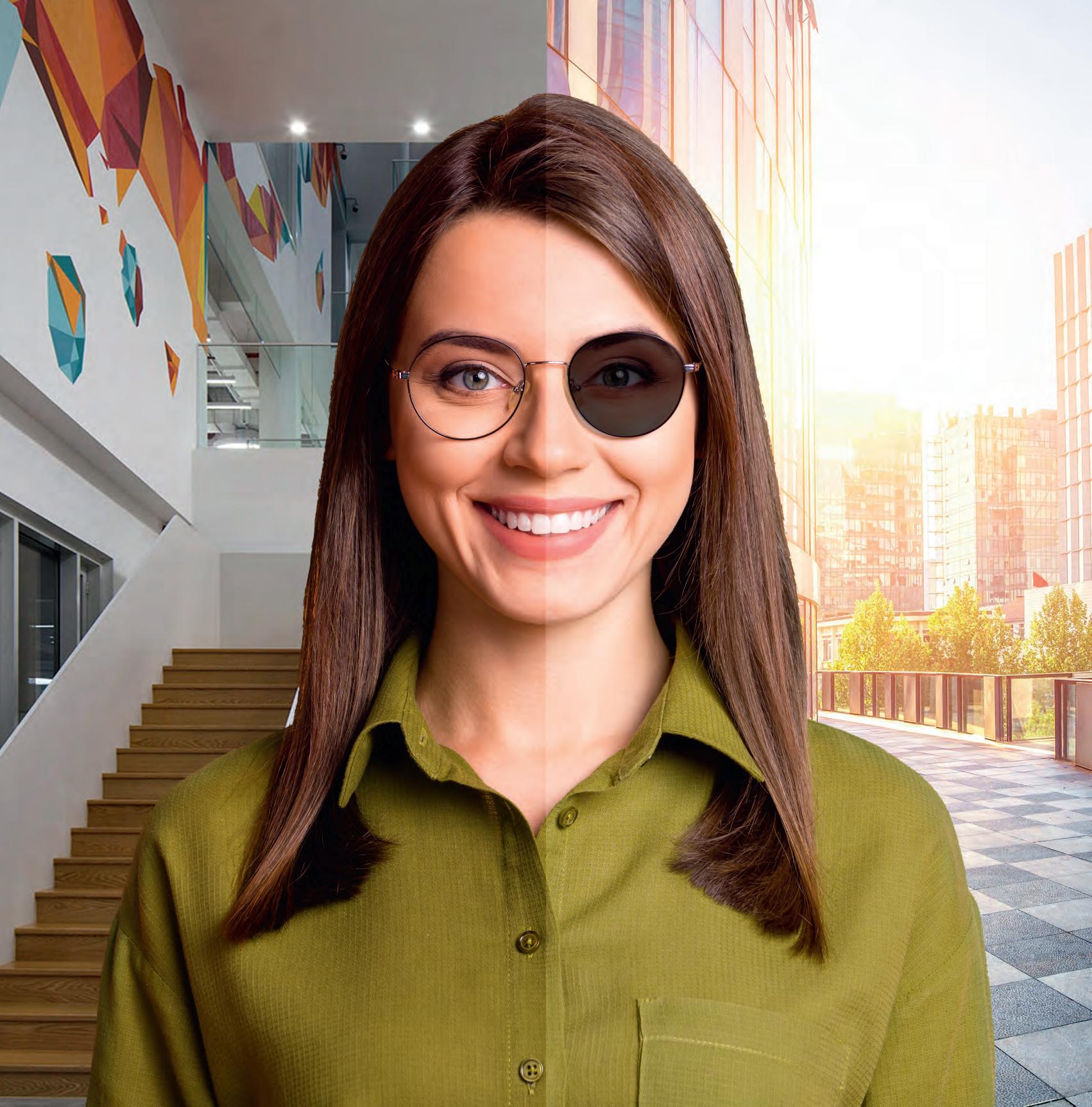


The new concept – with a lot of emotion
In addition to the new production facility in Germany, the brand's overall concept is also being updated. One reason is that Leica Eyecare also wants to support the specialist opticians with their new concept eyplains Bauer: “Opticians will be supplied with lenses that are made in Germany, by Leica, to a high quality standard and – most importantly – with a clear strategy. Because a brand like this can only be marketed by the brand itself, to ensure that the DNA, the emotions and also the intrinsic value of the brand all come across.” What is particularly important to Bauer is to be honest right from the start about what is being offered – and what is not. Five sales representatives have been given the task of successively finding suitable opticians who might be a good fit for Leica.

The company would like to have around 150 customers by the end of first year. The goals have been set realistically, since the company is starting from scratch with nothing but the customer database at the moment. Thus it's less about quantity, more about quality. This applies to the opticians too: “We don't want to flood the market and we don't have to be omnipresent.
That's not what we aspire to. We want to be partners. We want to offer retailers the chance to have an alternative. That is our goal. And that's also how we have positioned ourselves with the camera,” Jörg Bauer explains.

A select portfolio
For the company, deciding in favor of the brand and its repositioning has also meant consciously deciding against some products. For example, the portfolio will include no mineral lenses; and no polycarbonate either. As such, the lens manufacturer is pursuing exactly the opposite approach to many individual, smaller German manufacturers specializing in niche products such as mineral lenses.
Nor is it Leica Eyecare’s aim to constantly come up with a string of innovations. Instead, opticians should come to rely on consistently high quality with a dependable partner at their side. And when new products do come on the market, they should offer genuine added value. One example of this is a camera lens specifically matched to the brand which is currently under development.
 Sandra Reinl-Schulewski blocks spectacle lenses for testing puposes..
Sarah Ertle inspects spectacle lenses.
Sandra Reinl-Schulewski blocks spectacle lenses for testing puposes..
Sarah Ertle inspects spectacle lenses.
MAFO 4-23 34 MAFO LIVE ON SITE
In paperless manufacturing, the specatcle lens and tray gets „married“ several times
Bold marketing

In the area of marketing, the company is starting from an unusually bold concept – at least for our industry. The guiding principle here is that “Everyone deserves to see the world as authentically as possible.” The background to the concept is the idea that when you look at the world on your smartphone or social media, it is very often seen through filters, whether it's in a landscape photo or a selfie. This creates peer pressure for someone to be more beautiful than the next person. “And I find it utterly incredible that a 24-year-old with a well-toned six-pack should be wearing progressive lenses in an advertisement. That just doesn't seem right with me,” says Jörg Bauer. That's why the company is deliberately working with characterful models and, above all, with real people who don’t have to conform to the common ideal of beauty. Neither do they have to be young or have perfect skin. Thus the ads feature people with pigmentation disorders as well as women with gray hair.



A unique opportunity







At the end of the day, we have come to see that people work here out of conviction – starting with the CEO Jörg Bauer, via the employees in production to those in marketing. Everyone has played their part in ensuring that Leica Eyecare returns to its roots, in supporting the brand and promoting Wetzlar. “We have been able to create something that we will probably never have the chance to do again in our lives – building it up from scratch. One project may fail, but we won’t give up. If we succeed, I'll be happy in ten years’ time that we have built up a solid production, perhaps in a larger building. That we are active internationally and well represented in our core markets. And then, in ten years, I’ll gradually start to prepare my exit and ask the question: ‘Who can carry on the good work?’ But right now, for myself, I can't imagine doing anything else.” ◆


704 & 705 SILICONE DIFFUSION PUMP FLUIDS 617-227-1133 • 800-743-17 paula@filtech.com www.filtech.com SCAN FOR OUR FULL CATALOG QUAL SAVINGS FROM STOCK QUAL SAVINGS FROM STOCK QUALITY& SAVINGS FROM STOCK IONIZATION, THERMOCOUPLE & INSTRUTECH CONVECTION GAUGES INFICON RATE/THICKNESS CONTROLLERS & MONITORS Advertisement MAFO LIVE ON SITE
When there ist time, employees are getting creative. Frank Pfeffer analyzes the processes in the testing phase.
Ensuring that jobs and skills go hand in hand
How role-based descriptions instead of position and tasks can achieve this

WANTED! Employees urgently needed! In addition to an increasing shortage of suitably qualified people, there is another, and equally fundamental reason why positions remain unfilled: many jobs are defined too rigidly in terms of the tasks to be performed. And, as ever of course, one is always looking for the “jack of all trades” – with years of experience. The consequence is, that those with the right talents – as this is not only those at the beginning of their career who are often more willing to change – do not apply. So, it is time for the advantages of horizontal, agile ways of working to replace the more hierarchical structures traditionally favored by the personnel department.
By Timm Urschinger
MAFO 4-23 36 BUSINESS
If we are talking about Human Resources (HR) 2023, we are also talking about how to develop horizontal structures and autonomous teams. How to open up lines of communication between team members in different departments and how to break down barriers.
How to help employees develop their skills and work out how they can best contribute their talents and strengths. And how to use all these techniques to drive innovation and productivity in an organization forward.
We should not overlook the fact that in doing so, HR professionals can – indeed probably have to – improve and revitalize some of their key processes, such as performance management, succession planning or recruitment and talent acquisition by taking a more agile approach. This article, however, will focus particularly on the challenge of formulating job descriptions in horizontal systems, combined with agility and taking responsibility for one’s own work.
A key step which HR departments can take in this direction is to replace rigid job descriptions by a set of roles which a company is looking to fill.
Position-related work and recruitment
When a position is to be filled in an organization around the world, advertisements contain familiar details such as the formal title of the job, details of the position, a list of responsibilities and duties (usually already outdated by the time of hiring), and the name of the department to which the position reports.
Although this has long been the practice, finding people for rigidly defined positions in a hierarchical or vertical structure leads to unnecessary bureaucracy and challenges in many if not most companies – particularly if they are truly committed to agility and autonomously operating teams.
Often the job description does not accurately reflect what the person is expected to contribute to the company. A social media community
manager, for example, can do more than communicate with people on LinkedIn, Facebook or Twitter.

He can also help organize events or design promotional materials. Perhaps the sales department can turn to him or her for ideas on how to acquire new customers; or the communications department may need his or her skills to develop an internal social media platform. If HR were now to expand the scope of the job description to include what the community manager can actually do, the description may become too wide-ranging or vague, so that it is of little use for performance evaluation or the hiring process.
It will probably require a review of the function or salary level and certainly raise additional questions on the administrative side. Worst of all, even if the job description reflects the reality, it will soon become out of date, as projects come to an end or the expertise is needed elsewhere.
The challenge
A job today and in the future may require tasks and responsibilities that a single person cannot fulfill. Thus, the job description will become too idealistic.
HR managers therefore have to look for people with skills that match as many of these areas as possible – without assessing what a candidate could contribute on an overall basis, or bring to the company through one particular strength.
In a nutshell: What is “role-based working”?
Instead of defining job vacancies in terms of rigid positions, recruiters and/or HR managers should post a role description which includes the title of the role, e.g. community coordinator, the purpose of the role, and a list of tasks that fall entirely within the scope of that role and team or group.
Based on the example of the community manager, the last task on the list – helping with company-wide events – could be split off into a new role: event coordinator.
In this way, the person a company hires to connect with people on social media can also take on tasks such as organizing a major event – or not, as the case may be – depending on their skill set.
One key indicator that roles offer more flexibility and innovative opportunities is that – unlike positions – they do not match 1:1 with team members; which is also the biggest challenge when hiring in such a system.
So what does this look like in practice, if we don't have a clear 1:1 relationship? The employee with the community coordinator role does not have to worry about events; they can focus on social media engagement or something else – training, for example. What is critical is that more than one team member is capable of taking on the community coordinator role.
Rather than having overlapping roles and responsibilities, leading to boundaries that have to be crossed and weaken decision-making and hierarchy, roles can help team members to complement each other and act more decisively.
MAFO 4-23 37 BUSINESS
Three best practices for transitioning to role-based hiring and working
The process of breaking down rigid hierarchical positions into roles takes time and effort. Drastically changing the structure of an organization this way makes it more complex, especially when you consider that one person can hold multiple roles; but multiple people can also hold the same role.
This gets even more complicated when employees take on new roles or leave them, or when new employees are hired. On the other hand, it is worth the effort of focusing on the transparency and flexibility that these roles provide within the company. The following three tips will facilitate the transition to role-based hiring and working:
1. Identify key roles
One way to incorporate roles into the hiring process, without creating too much confusion and complexity for candidates unfamiliar with this type of organization and role-based working, is to identify a number of key roles.
These key roles take up the majority of new employees' time when they start their new job, and help to familiarize them with the idea of flexible and agile role-based working. The key roles are similar enough to the positions they might have expected, that they shouldn't cause applicants too many problems, while at the same time affording HR the opportunity to explain how role-based working really works.
If the key roles take up about 60-80% of the new employee´s time, they still have time to take on other roles, as they get to know the structure of the company. During this acclimatization phase, HR – or even better the hiring team – should explain how the roles work, how they may change over time, and how team members can best manage their time to fulfill them. It is also a good idea to share the role-based organizational chart with new employees. It is likely that looking over the non-key tasks may actually stimulate interest and motivation. After all, we all want to learn and develop further!

2. Separate the definition of roles and remuneration
Another way to make an organization's role-based structure work smoothly in the labor market is to simplify remuneration and avoid tying salary to the number or complexity of roles a candidate is assigned. This would make administration more cumbersome, as organizations not only have many different roles, but also specific roles that particular people hold. One also wants to avoid people taking on roles simply to get into a higher pay grade.
To get around this, organizations should define grades and functions for hiring, and set the remuneration accordingly. In practice, a job posting would include this or that pay grade, and applicants' salaries would be determined based on this. Of course, the interview would focus on how well the applicant fits the role they are applying for, not how close they are to a particular pay grade or range.
3. Hire on a truly role-based approach!
Organizations should advertise all vacancies that need to be filled. This should not just be on a “once-a-year-for-three-days”basis. If vacancies are posted in Peerdom or Holaspirit (software platforms that provide clarity and transparency at all levels, to help companies on the path to self-organization), additional information should be included such as: how much work on average it is expected this position will involve – or even better, how much work it requires today.
Candidates can then choose to apply for a specific role, perhaps a part-time position with all the benefits this implies both for the employer and the employee. Or candidates can choose to apply for a range of roles, a sort of “role package”. This package could then take up 80-100% of their time and will likely reflect their interests and hopefully their strengths.
The additional complexity is that organizations will have a multitude of role packages and combinations to offer, potentially making it more difficult to decide on a candidate because it could mean tradeoffs regarding other positions and their hiring processes. The major benefit, however, is that candidates who truly embrace a role-based approach to work will come forward, and organizations will genuinely find candidates that others failed to hire because the job descriptions were too inflexible. Thus, companies open themselves up in the labor market to highflyers and people who want to make a career change – with all the benefits that entails.
Role-based working holds an enormous potential to boost a company’s agility. While it is important to focus on defining these internal roles clearly and getting the organizational structure right, one should not forget how HR can apply these practices to hiring and other functions like remuneration – and the challenges associated with these.
Trailblazers already exist that are doing a great job demonstrating how this can work, helping companies solve the challenges of finding the right talent to fill vacant positions. ◆
Timm Urschinger is co-founder and CEO of LIVEsciences. After his studies and several years working for a well-known pharmaceutical group in Switzerland, and in consulting, he decided to set up his own company. His expertise in managing global programs and transformation inspired in him a passion for developing pragmatic and innovative solutions – both for his own company and for customers. New organizational models like Teal play an equally important role as selfleadership, so that people once again feel a sense of purpose and enjoyment in their professional lives. https://www.livesciences.com
Timm Urschinger
MAFO 4-23 38 BUSINESS
Do

want to know more about us?

IOT offers advanced ophthalmic technology solutions from the initial design and development to the industrial manufacturing process. Their products create added value and offer a boost of innovation for any company or laboratory, regardless of size. Discover how collaborating with us can revolutionize your operations. www.iotlenses.com Contact our Sales Team! a unique team
have an elite team, cohesive and accessible to all our partners. We are focused exclusively on our field of expertise, with in-depth knowledge in different areas of the ophthalmic and optical industry. We are dedicated to building a collaborative relationship with our partners. We exist to amplify your business.
ARE
We
WE
you
Hard coating machines
An extremely robust hard coating is a top priority for spectacle wearers and manufacturers. Processes are constantly being improved to optimize the coatings while offering modern machines that meet all requirements of labs worldwide. In the following market overview, MAFO has summarized the most important criteria and differences of hard coating machines, to make it easier for customers to find the perfect match. The survey is divided into dip hard coating machines and spin hard coating machines.

Special MAFO 4-23 40 SPECIAL
MARKET SURVEYS
Dip Hard Coating Machines
4 Cleaning x x x Priming x x x Photochromic process option o o Hard coating x x x Pre-polymerization x x x Number of separate handling systems for batch movement 1 1 2 Automatic lens loading/unloading / x x Features



- swappable as standard (Primer/HC/AFC), 4 position storage station as option. Solvent refilling (automatic / semi automatic) o/x o/x Detergent refilling (automatic / semi automatic) -/x o/x o/x DI Water refilling (automatic) x x x Recycling and filtration of detergent x x x Dip coating control by servo-driven programmable motor x x x Barcode scanner o o o Remote diagnostic x x x Camera monitoring system o o o LMS connectivity o o o Further information Highly compact system without compromising on quality or functionality
3 standard (primer/HC/AFC)
double Advanced dip coating for the modern lab. Providing superior quality, functionality, process control
The most advanced dip coating system for the larger lab. Legend: Yes = x, No = /, Optional = o MAFO 4-23 41
HCS 20 HCS60 HCS200 Application Small labs ( < 100 L/ shift) x Medium sized labs (100 - 3000 L/shift) x x Mass production labs ( > 3.000 L/shift) x Lens materials all organic materials all organic materials all organic materials Technical data Typical productivity (lenses / hour) index 1.5 20 60 200 Typical productivity (lenses / hour) index 1.6 20 60 200 Batch size 1 pair 3 pairs 8 pairs Cleaning steps 6 (etch, spray, sonic clean, spray, double DI, dry) 6 (etch, rinse, sonic clean, rinse, double DI, dry) 8 (etch, etch, rinse, sonic clean, rinse, DI, DI, dry) note: DI separate circuits not same water in 2 tanks Coating tanks
Bühler, powered by Shyre www.buhlergroup.com, www.shyre.co.uk
Tank capacity (liter) Cleaning: single 2.5l / double 5l, Coating: 2.5l Cleaning: Single 3.5l /
3 standard/4 option primer/ HC/AFC), swappable tanks and storage station as option 7l, Coating: 3.5l Cleaning: single 8l / double 17l, Coating: 9l Weight (kg / lbs) 750kg / 1650lbs 1000kg / 2200lbs 1800kg / 3960lbs Dimensions (w x d x h) / [ mm / inches] (machine without conveyor) 1720 x 1000 x 2000 2420 x 1000 x 2000 5720 x 1080 x 2000 Process
Bühler, powered by Shyre Optimal Technologies www.buhlergroup.com, www.shyre.co.uk www.optimal-technologies.com
Dip Hard Coating Machines




Umbra60 Umbra200 CHC60-S4 SR CHC150-S4 XL Application Small labs ( < 100 L/ shift) x x Medium sized labs (100 - 3000 L/shift) x x x x Mass production labs ( > 3.000 L/shift) x x Lens materials all organic materialsall organic materials x Technical data Typical productivity (lenses / hour) index 1.5 40-60 150-200 60 150 Typical productivity (lenses / hour) index 1.6 40-60 150-200 60 150 Batch size 3 pairs 8 pairs 6 16 Cleaning steps 6 (etch, rinse, sonic clean, rinse, double DI, dry)
tanks 7 (ultrasonic cleaning, rinsing, DI cleaning and DI rinsing) Coating tanks 3 standard/4
(Primer/HC/AFC), swappable tanks and storage station as option
option. 2 primer and 2 top coat Tank capacity (liter) Cleaning: single 3.5l / double 7l, coating: 3.5l Cleaning: single 8l / double 17l, coating: 9l 4 7 Weight (kg / lbs) 1000kg / 2200lbs1800kg / 3960lbs 750kg 2090kg Dimensions (w x d x h) / [ mm / inches] (machine without conveyor) 2420 x 1000 x 20005720 x 1080 x 20002800 x 1162 x 20414081 x 1389 x 2059 Process Cleaning x x x x Priming x x x x Photochromic process option x x / / Hard coating x x x x Pre-polymerization x x x x Number of separate handling systems for batch movement 1 2 x x Automatic lens loading/unloading x x o o Features Solvent refilling (automatic / semi automatic) o/x o/x x x Detergent refilling (automatic / semi automatic) o/x o/x o o DI Water refilling (automatic) x x x x Recycling and filtration of detergent x x x x Dip coating control by servo-driven programmable motor x x x x Barcode scanner o o o o Remote diagnostic x x x x Camera monitoring system o o o o LMS connectivity o o o o Further information The photochromic coating system for Rx labs Comprehensive fully functional dip coating including photochromic for larger production Legend: Yes = x, No = /, Optional = o MAFO 4-23 42 MARKET SURVEYS
8 (etch, etch, rinse, sonic clean, rinse, DI, DI, dry) note: DI separate circuits not same water in 2
option
4 Swappable as standard (Primer/HC/AFC), 4 position storage station as
7 (ultrasonic cleaning, rinsing, DI cleaning and DI rinsing)
7 (ultrasonic cleaning, rinsing, DI cleaning and DI rinsing)


10 (ultrasonic cleaning, rinsing, DI cleaning and DI rinsing)


12 (ultrasonic cleaning, rinsing, DI cleaning and rinsing, drying)
2 primer and 2 top coat (optional additonal coating stage available)
2 primer and 2 top coat (optional additonal coating stage available) 1
Optimal Technologies www.optimal-technologies.com CHC200-S4 CHC360-S4+ CHC1000-S2 CHC3000-S4 x x x x x x x x x x x x x 200 360 1000 3000 200 360 1000 3000 20 36 112 200
1 top
primer and
coat
2
10 17 26 70 2340kg 2570kg 9000kg TBD 5941 x 1620 x 2170 5942 x 1620 x 2170 14879 x 1680 x 2186 22500 x 2100 x 2300 x x x x x x x x x x x x x x x x x x x x x x x x o o o x x x x x o o o x x x x x x x x x x x x x o o o x x x x x o o o o o o o o Automatic lacquer dosing MAFO 4-23 43 MARKET SURVEYS
2 primer and
top coat
Dip Hard Coating Machines


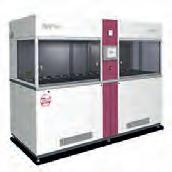
OptoTech www.optotech.net/en OHC-60 OHC-150 OHC-200 Application Small labs ( < 100 L/ shift) x Medium sized labs (100 - 3000 L/shift) x x Mass production labs ( > 3.000 L/shift) x Lens materials all organic materials Technical data Typical productivity (lenses / hour) index 1.5 60 150 200 Typical productivity (lenses / hour) index 1.6 60 150 200 Batch size 3 pairs 8 pairs 10 pairs Cleaning steps 7 cleaning (2 etch, rinse, clean, rinse, 2x DI) 1 drying oven Coating tanks 2 primer 2 hard coating Tank capacity (liter) Cleaning 9 l / coating 4 l Cleaning 15 l / coating 8 l Cleaning 13 l / coating 10.5 l Weight (kg / lbs) Dimensions (w x d x h) / [ mm / inches] (machine without conveyor) 3480 x 1000 x 2050 3920 x 1200 x 2000 5028 x 1425 x 2170 Process Cleaning x x x Priming x x x Photochromic process option o o o Hard coating x x x Pre-polymerization x x x Number of separate handling systems for batch movement 1 1 1 Automatic lens loading/unloading o o o Features Solvent refilling (automatic / semi automatic) x (automatic) x (automatic) x (automatic) Detergent refilling (automatic / semi automatic) o (automatic) o (automatic) o (automatic) DI Water refilling (automatic) x x x Recycling and filtration of detergent x x x Dip coating control by servo-driven programmable motor x x x Barcode scanner o o o Remote diagnostic x x x Camera monitoring system o o o LMS connectivity o o o Further information Legend: Yes = x, No = /, Optional = o MAFO 4-23 44 MARKET SURVEYS
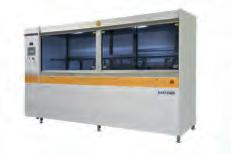



www.schneider-om.com DC-4S DC-6S DHC 20 DHC40 DHC60 / / x x / x (1 shift = 8 hours) x x x / / all organic lenses all organic materials 48 72 20 40 60 48 72 20 40 60 2 pairs 3 pairs 2 4 6 7 steps (detergent tanks, rinsing tank with tap water, rinsing tank with DI water, drying with infrared) 7 7 7 3 (1 primer and 2 varnishes) 1 primer 2 hard coat 2 primer 2 hard coat 1 primer 2 hard coat 3 (varnish tanks capacities)3,8 (varnish tanks capacities)1,5 l (coating) 3,7 l (coating) 3,7 l (coating) 720 / 1587 720 / 1587 1200 / 2646 1330 / 2933 1350 / 2977 3311 x 1215 x 2266 / 130 x 48 x 89 3311 x 1215 x 2266 / 130 x 48 x 89 2120 x 1000 x 2120 / 84 x 40 x 84 3015 x 1100 x 2105 / 119 x 39 x 83 2880 x 1000 x 2050 / 114 x 39 x 81 x x x x x x x x x x / / x x x x x x x x x x 1 1 x x x / / / / / auto auto a a a auto auto x x x x x x x x x x x x x x x / / o o o x x x x x / / o o x x x MAFO 4-23 45 MARKET SURVEYS
Satisloh Schneider www.satisloh.com
Dip Hard Coating Machines
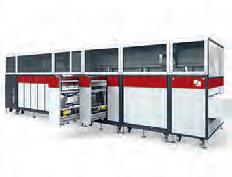


Schneider www.schneider-om.com DHC60-SR DHC200 DHC300 Application Small labs ( < 100 L/ shift) / / / Medium sized labs (100 - 3000 L/shift) x x x Mass production labs ( > 3.000 L/shift) x x Lens materials all organic materials Technical data Typical productivity (lenses / hour) index 1.5 72 200 300 Typical productivity (lenses / hour) index 1.6 72 200 300 Batch size 8 20 28 Cleaning steps 7 7 7+ Coating tanks 2 primer 2 - 3 hard coat 2 primer 2 hard coat 3 primer 3 hard coat Tank capacity (liter) 3,7 l (coating) 9 l (coating) 7 l or 14 l (coating) Weight (kg / lbs) 1550 / 3417 1900 / 4189 5000 - 6000 / 11023 - 13227 Dimensions (w x d x h) / [ mm / inches] (machine without conveyor) 3480 x 1050 x 2050 / 137 x 41 x 815475 x 1424 x 2042 / 215 x 56 x 8010850 x 1900 x 2270 / 427 x 75 x 89 Process Cleaning x x x Priming x x x Photochromic process option Hard coating x x x Pre-polymerization x x x Number of separate handling systems for batch movement x x x Automatic lens loading/unloading / / / Features Solvent refilling (automatic / semi automatic) a a a Detergent refilling (automatic / semi automatic) a DI Water refilling (automatic) x x x Recycling and filtration of detergent x x x Dip coating control by servo-driven programmable motor x x x Barcode scanner o o x Remote diagnostic x x x Camera monitoring system LMS connectivity x x x Further information Legend: Yes = x, No = /, Optional = o MAFO 4-23 46 MARKET SURVEYS
all organic materials all organic materials
330 to 380 (max. average)160 to 190 (max. average)140 to 160 (max. average)60 to 80 (max. average)60 (max. average) 330 to 380 (max. average)160 to 190 (max. average)140 to 160 (max. average)60 to 80 (max. average)60 (max. average) 14 to 16 pairs
to 8 pairs 7 to 8 pairs 3 to 4 pairs 3 pairs
8 steps (detergent tanks, rinsing tank with tap water, rinsing tank with DI water, drying with infrared)
3 tanks (1 primer and 2 varnishes)
7 steps (detergent tanks, rinsing tank with tap water, rinsing tank with DI water, drying with infrared)
3 tanks (1 primer and 2 varnishes)
7 steps (detergent tanks, rinsing tank with tap water, rinsing tank with DI water, drying with infrared)
3 tanks (1 primer and 2 varnishes)
7 steps (detergent tanks, rinsing tank with tap water, rinsing tank with DI water, drying with infrared)
3 tanks (1 primer and 2 varnishes)
18,4 liters (coating tank)10 liters (coating tank)9,5 liters (coating tank)5 liters (coating tank)5 liters (coating tank)





SCL www.scl-intl.com/fr/ CDS2000 CDS1000 CDC1000 CDC500 CDC400 / / / / x / x x x / x / / / /
7
2800
1450
1020
750 kg 650 kg 8540 x 1850
2700 4888
1657
2318 3591mm
1555mm
2087mm 3591mm x 1362mm x 2047mm 3167mm x 1235mm x 2047mm x x x x x x x x x x / / / / / x x x x x x x x x x 2 1 1 1 1 x x / / / auto auto auto auto auto auto auto auto auto auto x x x x x x x x x / / / / / / / / / / / x x x x x / / / / / o o o o o MAFO 4-23 47 MARKET SURVEYS
kg
kg
kg
x
x
x
x
x
Spin Hard Coating Machines
Smaller footprint Velocity system with recipe-driven environment for customized coating and curing.
Backside spin coater with wash, coat, UV cure stations. Coating is thermally controlled, keeping viscosity consistent.

First generation automated Velocity backside spin coater with wash, coat, UV cure stations. Coating is thermally controlled, keeping viscosity consistant.
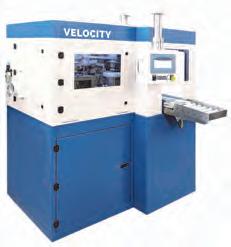

Coburn Technologies www.coburntechnologies.com Velocity LTE Spin Coating SystemVelocity Manual Spin CoaterVelocity Automated Spin Coater Technical data Lens materials all materials (except glass) Typical productivity (lenses / hour) 90 120 120 Lenses in process 3 4 6 Tank capacity (ml/ fl. oz.) 266 / 9 266 / 9 266 / 9 Suitable for solid based lacquer x x x Suitable for solvent based lacquer / o o Weight (kg / lbs) 260 / 573 204-227 / 450-500 295-318 / 650-700 Dimensions (w x d x h) / [mm / inches] (machine without conveyor) 946 x 711 x 1778 / 37.25 x 28 x 70864 x 864 x 1753 / 34 x 34 x 691544 x 1545 x 1753 / 61 x 61 x 69 Process Fine cleaning x x x Drying x x x Coating application range (µm) 4.5 - 6.5 4.5 - 6.5 4.5 - 6.5 UV-curing with integrated energy control x x x Off-the-block processing x x x On-the-block processing / / / Automatic lens loading/unloading / / x Features Barcode scanner / / x Remote diagnostic o o o LMS connectivity / / x
Further information
Legend: Yes = x, No = /, Optional = o MAFO 4-23 48 MARKET SURVEYS
Second generation automated Velocity coater with the option of adding a second coating station.
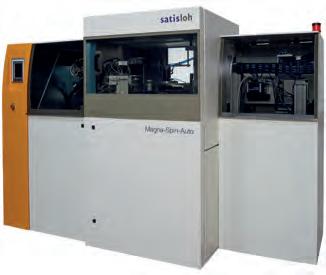


Coburn Technologies Satisloh www.coburntechnologies.com www.satisloh.com Velocity 2D Automated Spin Coater Magna-Spin Magna-Spin-Auto all materials (except glass) all organic up to 1.67 140 up to 90 with solvent based chemistry up to 100 with all solids chemistry up to 110 with solvent based chemistry up to 120 with all solids chemistry 6 3 6 266 / 9 1500 / 50 x x x o x x 363-386 / 800-850 400 / 882 600 / 1336 1728 x 1448 x 1829 / 68 x 57 x 72 956 x 1100 x 1800 / 38 x 43 x 71 3210 x 1302 x 1808 / 126 x 51 x 71 x x x x x x 4.5 - 6.5 1,8 - 8 x x x x x x / x (ART blocks only) x (ART blocks only) x / x x o x o x x x x x
MAFO 4-23 49 MARKET SURVEYS
Spin Hard Coating Machines

Further information
2 HC-solutions can be handled at the same time.
Benchtop design suitable for smaller labs or offices. Separated cure unit allows for lens inspection before curing.

Fully integrated system that automatically cleans, coats, and cures lenses in one quick, uninterrupted cycle.
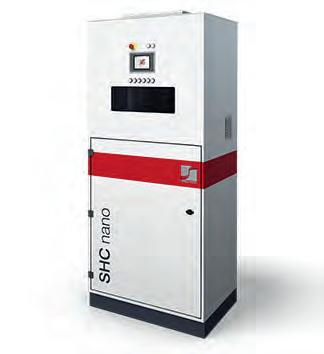
Schneider Ultra Optics www.schneider-om.com www.ultraoptics.com SHC-Nano Mini2 MR3 Technical data Lens materials all organic materials all materials Typical productivity (lenses / hour) 60 40 80 Lenses in process 4 1 3 Tank capacity (ml/ fl. oz.) 0,375 / 12,68 243 / 8 364 / 12 Suitable for solid based lacquer x x x Suitable for solvent based lacquer o x / Weight (kg / lbs) 300 / 661 136 / 300 293 / 645 Dimensions (w x d x h) / [mm / inches] (machine without conveyor) 840 x 620 x 1960 / 33 x 24 x 77 635 x 533 x 914 / 25 x 21 x 36 635 x 762 x 2032 / 25 x 30 x 80 Process Fine cleaning x x x Drying x x x Coating application range (µm) 3-8 4 - 6 microns 4 - 6 microns UV-curing with integrated energy control x x x Off-the-block processing x x x On-the-block processing / / / Automatic lens loading/unloading o / / Features Barcode scanner x / / Remote diagnostic x / / LMS connectivity x / /
Legend: Yes = x, No = /, Optional = o MAFO 4-23 50 MARKET SURVEYS
Fully integrated system that automatically cleans, coats, and cures lenses while still on the block.
Fully automated, conveyor fed, and robotically loaded coater with the capability to scan jobs and connect to your LMS
Fully automated unit with two coating reservoirs and the capability of job-to-job recipes and remote diagnostics.

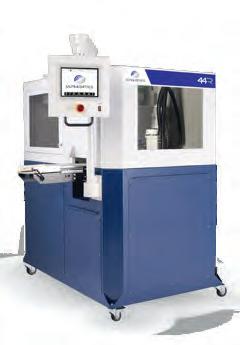

Ultra Optics www.ultraoptics.com OTB 44R 54R all materials 80 120 160 3 4 5 364 / 12 364 / 12 728 / 25 x x x / / / 293 / 645 1034 / 2280 907 / 2000 635 x 762 x 1930 / 25 x 30 x 76 1854 x 1626 x 1803 / 73 x 64 x 71 1067 x 1168 x 2108 / 42 x 46 x 83 x x x x x x 4 - 6 microns 4 - 6 microns 4 - 6 microns x x x / x x x x x / x x / x x / x x / x x
MAFO 4-23 51 MARKET SURVEYS






















HARD COAT LEADER 271 rue Laszlo Biro Archparc FR-74160 Archamps Phone : +33 (0) 450 820 720 Email : office1@scl-intl.com scl-intl.com HARD COATING CLEANING TINTING CONSUMABLES EXPERTISE Cleaningad: World leaders in Lens Hard Coating Machines and process solutions Full range available for any production volume Expert advice on your application World leaders in Ultrasonic Cleaning Machinesprior to lens coating Full range available for any lens volume Expert advice on your application Contactusfor our full range: +44 (0) 1462491616 sales@optimal-technologies.com www.optimal-technologies.com sales@optimal-technologies.com optimal-technologies.com contact us: (+44) 1462 49 16 16 optics@fisa.com www.fisa.com Pub FISA - Optical World 88x40.indd 1 14/12/2021 16:49 Cleaning and hard coating equipment Suppliers Guide The Suppliers Guide is MAFO’s version of Yellow Pages. In it you can find an overview of suppliers from the fields of: ▶ cleaning and hard coating equipment ▶ coating equipment ▶ crystals ▶ laser engraving & printing ▶ lens surfacing machinery ▶ lenses ▶ machinery – automation, control & packaging ▶ machinery – lens edging & industrial edging ▶ software ▶ surfacing and finishing consumables ▶ vacuum coating materials If you are interested in an entry in the Suppliers Guide, please contact Mrs. Classen: constanze.classen@mafo-optics.com Bühler Alzenau GmbH Business Area Leybold Optics Siemensstrasse 88, D-63755 Alzenau T + 49 (0) 6023 500-0, F + 49 (0) 6023 500-150 leyboldoptics@buhlergroup.com www.buhlergroup.com Coating equipment UV Curable Hard Coat Adhesion On All Lenses Tintable Non-Solvent Based AR Coating Compatible Sales, Distributors Wanted Shipping Worldwide www.hcoating.com sales@hcoating.com Crystals MAFO 4-23 52
Optical Machinery. Processing Technology. OptoTech Optikmaschinen GmbH








































Sandusweg 2-4 • 35435 Wettenberg/Germany
Tel.: + 49 641/98203-0
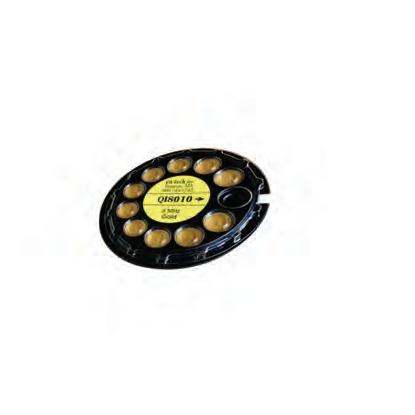





















eMail: info.de@optotech.net
Web: www.optotech.net
OPTICAL MANUFACTURING SOLUTIONS



















Satisloh AG
Neuhofstrasse 12
CH - 6340 Baar / Switzerland
Phone: +41 (0) 41766 16 16
Email: info@satisloh.com satisloh.com
SCHNEIDER GmbH & Co. KG


Biegenstrasse 8–12 · 35112 Fronhausen · Germany
Phone: +49 (64 26) 96 96-0 · Fax: +49 (64 26) 96 96-100


www.schneider-om.com · info@schneider-om.com


Lenses
!AZ.indd 9
Lens surfacing machinery Lens surfacing machinery Enjoy, • unlimited designs • digi-speed process www.tecofrance.com info@tecofrance.com Choose your frame colour White Green Blue Red Cyan Purple X-Cube Lens Digi-speed Printer PUB_TECO-Juillet 2016.indd 1 25/07/16 17:59
paula@filtech.com • Sensor Heads and Feedthroughs • INFICON Deposition Monitors and Controllers • Quality Crystals® • Vacuum Pump Fluids • Vacuum Measurement Gauges • Electron Beam Gun Parts • Ion Source Parts 617-227-1133 • 800-743-1743 www.filtech.com 19.10.21 12:11 Crystals Laser engraving & printing Premium-Quality Laser Engraving of Spectacle & Contact Lenses Industry approved since 2004 www.ophthalmic-marking.com 30.11.20 12:42 Suppliers Guide MAFO 4-23 53 SUPPLIERS GUIDE
QUALITY &
SAVINGS FROM STOCK QUALITY & SAVINGS FROM STOCK QUALITY
& SAVINGS FROM STOCK
Machinery - Automation, Control & Packaging




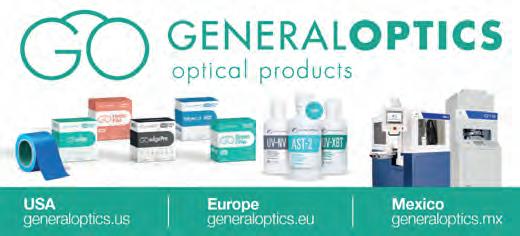
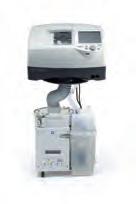



Machinery - lens edging & industrial edging
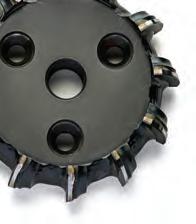


Combination of dynamic ideas and stable performance provides superb Lens Edging
Software
Surfacing and finishing consumables
20
T l. : +33 (0)1
- Fax
contact@agp-abrasifs.com - www.agp-abrasifs.com
EDGING
The Lab Management System Company LensWare International GmbH Robert-Bosch-Str. 32 63225 Langen - Germany Phone : +49 6103 / 372 87 87 Email : info@lensware.de Web : www.lensware.de IOT is a premier provider of disruptive and customized innovations in the optical industry
avenue Reille - 75014 PARIS - FRANCE
45 89 84 44
: +33 (0)1 45 89 66 54
GENERATING POLISHING
!AZ.indd 3
www.nidek.com info@nidek.co.jp
!AZ.indd
www.cotec-gmbh.com
Suppliers Guide
1
DURALONHydrophobic Premium Coatings
YOUR ULTRA PRECISION Diamond Tools Manufacturer
> Compliant with any generator > Excellent service and quick turnaround ky diamond.ca sales @ kydiamond.ca
05.10.17
MAFO 4-23 54 SUPPLIERS GUIDE
17:18
第 三十四屆 中国国际眼镜业展览会 THE 34th CHINA
第 三 十 四 届中国国际眼镜业展览会 THE 34th CHINA
INTERNATIONAL OPTICS FAIR
INTERNATIONAL OPTICS FAIR
11-13/09/2023

主办单位 ORGANIZERS:
中国眼镜协会
China Optometric & Optical Association
: (86) 10 8355 9070/71/72
: (86) 10 8355 9075
: cooa@chinaoptics.com


: www.chinaoptics.com
中国中轻国际控股有限公司
Sinolight International Holdings Corporation

赞助单位 SPONSORED BY:
香港贸易发展局
Hong Kong Trade Development Council
香港中华眼镜制造厂商会
Hong Kong Optical Manufacturers Association

北京市眼镜行业协会
Beijing Optometric & Optical Association
协办单位 CO-ORGANIZERS:
香港东方国际展览有限公司
Orient Int'l Exhibition Co., Ltd. (H.K.)
: (852) 2789 3220
: (852) 2789 3260
: orientex@netvigator.com
: www.orientexhibition.com.hk
支持单位 SUPPORTED BY:
中国轻工业联合会
China National Light Industry Council
批准单位 ENDORSED BY:
中华人民共和国商务部
Ministry of Commerce, P.R. China
CIOF 2023
Ivette Bruguera
– a technical affine all round talent and music lover
Ivette Bruguera is Product Manager at Horizons Optical and holds a degree in Optics and Optometry from the Polytechnic University of Catalonia, as well as a master's degree in Project Management from the Management School of Madrid. She has over four years of experience as the lead of EMEA technical support, where she gained valuable expertise in visual solutions, evaluation, reporting, surfacing processes, quality processes, and standards. Currently, she plays a key role in product development and launches at Horizons Optical and possesses profound knowledge of market products and trends. Besides her profession the 27-years old loves music.

If you could change one thing in the world, what would that be?
I would change the way the world treats others. I believe in promoting kindness and empathy, where people help each other without expecting anything in return.
In your opinion, which movie should everyone have seen?
In my opinion, everyone should have seen La vita è bella. I think the message it conveys is incredibly important: finding happiness even in the face of adversity, and the power of love and optimism.
If you had to do without one of your senses – vision or hearing –which would it be? Hearing.
What is your favourite place in the world?
My little town. However, if I could choose one country to live in, it would be Switzerland, as it boasts breath-taking landscapes and a high quality of life.
What does a perfect day at work look like to you?
A perfect day at work would involve a productive balance between attending meetings, completing tasks, and effectively prioritizing my next steps.
Which profession did your parents have in mind for you?
A profession that allows me to help others.
If you didn’t do your current job, what else would you do? Neurosurgeon.
What is the best thing about your job?
The incredible team that I have by my side.
What does a new customer mean to you?
A new customer represents a fresh opportunity for me to learn, grow professionally, and provide them the excellent service.
What would you do differently in your next life?
In my next life, I would learn more languages. ◆
MAFO 4-23 56 CLOSING WORDS
Did you know how snakes see?
Because snakes do not have eyelids, they cannot blink. The missing eyelids are the result of a long evolutionary process. In the distant past, snakes shared their home with hungry dinosaurs, and to survive they had to adapt. One of these adaptations was the switch to a more nocturnal lifestyle. As this transition occurred, the snake´s eye became more simple. Presumably, this is where the snakes lost the eyelid and developed scales that allowed them to keep their eyes open all the time. But how do snakes sleep if they can´t close their eyes? Presumably, they can sleep with their eyes open thanks to their reptilian brain. By the way, nocturnal snakes look through a transparent lens that allows them to see better at night. Diurnal snakes, on the other hand, have a yellow lens that filters out dangerous UV light and protects the retina, much like sunglasses.

Special topics in MAFO 2023
Preview MAFO 05/2023
The special topic of MAFO 05/2023 is Sustainable Processes. Find out more about new eco-friendly technologies in the ophthalmic optics industry, benefits of a sustainable employee management and how experts evaluate the status quo, in terms of sustainability, in the eyewear industry. Further articles cover the topics "coating of spectacle lenses", "software technologies to reduce the thickness and weight" and many more exciting topics.

MAFO 4-23 57 OUTLOOK
MAFO 03 Technology & Innovation MAFO 01 MAFO 05 Sustainable Processes Future Lab MAFO 02 MAFO 04 Data Handling & Security MAFO 06 Go Digital! Ophthalmic Optics in Numbers
PUBLISHERS ADDRESS
Eyepress Fachmedien GmbH

Saarner Str. 151, D-45479 Muelheim a. d. Ruhr
Tel.: +49-208-306683-00
Fax: +49-208-306683-99
Website: www.mafo-optics.com
E-mail: info@mafo-optics.com
CEO Petros Sioutis
E-mail: p.sioutis@eyepress.de
PUBLISHER
Silke Sage, Petros Sioutis, Efstathios Efthimiadis
FOUNDED 2003 by Jörg Spangemacher

BANK DETAILS
Bank account: Sparkasse Aachen
Bank No.: 390 500 00, Acc. No.: 1073 3925 06
IBAN: DE21 3905 0000 1073 3925 06
SWIFT: AACSDE33XXX
CHIEF-EDITOR
Hanna Diewald
E-mail: hanna.diewald@mafo-optics.com


EDITORS
Rebekka Nurkanovic
E-mail: rebekka.nurkanovic@mafo-optics.com
Britta Laupichler
E-mail: britta@mafo-optics.com
TRANSLATIONS
John Saniter, Bopfingen
EDITORIAL BOARD
Jörg Spangemacher, Peter Baumbach, Mo Jalie
PRODUCTION & LAYOUT
Efstathios Efthimiadis, Pascal Bruns
E-mail: production@eyepress.de
DISTRIBUTION
PressUp GmbH, Postbox 70 13 11, D-22013 Hamburg
Tel.: +49-40-386666-308, Fax: +49-40-386666-299
MEDIA CONSULTANT
Constanze Classen
Tel.: +49-208-306683-20
E-mail: constanze.classen@mafo-optics.com


ADVERTISING AGENT GREAT CHINA
Beijing FOCUS Optics Culture Communication Co. Ltd.

Room 319, Building 2, Nr. 1, Northbank 1292, Nr. 15
J ianguo Eastroad, Beijing 100024 (Chaoyang), P.R. China
Mrs. Jian Wang
Tel.: +86-10-8537-6529

Email: jennywang_focus@126.com
Skype: jennywang611
焦点视光(北京)文化传播有限公司
北京市朝阳区建国东路15号院甲一号北岸1292
二号楼319室 邮编:100024
电话:+86-10-8537-6529
电邮:jennywang_focus@126.com
ADVERTISEMENT RATES
Price list no. 19, valid from January 01, 2023
Publication schedule
6 issues 2023: January, March, May, July, September, November
SUBSCRIPTION COSTS PER YEAR
European Union € 1 40,00 (plus VAT for German companies)
Overseas Seamail € 160,00

Overseas Airmail € 195,00


United States Seamail € 170,00
United States Airmail € 2 25,00
Single issue € 20,00 (plus mailing costs)
The Publisher requires three months written notice on cancellation. Subscribers please note that proof of notice may be required.
PHOTO CREDITS
P.14: Emiliia, P.18: metamorworks, P.21: Vitor Miranda. P.22: artographer34, P.26: standret, P.36: Andrey Kiselev /stock.adobe.com, /unsplash.com



PRODUCTION & PRINT Kollin Medien GmbH, Neudrossenfeld, Germany
The publisher takes no responsibility for unsolicited manuscripts. Please note also that photographs submitted for use in MAFO cannot be returned. The publisher’s written permission is required for any reproduction, translation or recording of material published in MAFO, including extracts of such material. Permission will normally be given, subject to the usual acknowledgement. Copies made of published items must be limited i n number and for personal use only.
3/2023 ▶ Special topic: Ophthalmic Optics The ophthalmic market in nutshell Misconceptions about progressive lenses Consumer sentiment and market data in Europe Technology Natural Accommodation Lens PFAS forever? Market Survey OPHTHALMIC LABS & INDUSTRY Eyepress Fachmedien GmbH Saarner Str. 151 We help you to stay in contact BLOCKING PERFORMANCE AT A NEW LEVEL One auto blocker covering virtually all of labs’ blocking requirements at highest automated block size exchange and achieves unprecedented efficiency in blocking. block sizes minimum of three and up to six readily available. And the best part: The exchanges are carried out automatically and without increasing cycle time. With the added flexibility, CCU Modulo ONE solves well-known problem: Inefficient block size distribution and poor machine utilization. For any lab size, wider range of blocking requirements can be met with a smaller number of machines. The proprietary lens measuring unit guarantees perfectly oriented lenses. An intelligent fill control provides highly consistent and precise fillings – no under or over fillings. The alloy and block pieces can be refilled during operation. Non-stop uninterrupted blocking for highest throughput, at lowest cost per lens. www.schneider-om.com CCU m dulo 3/2023 ▶ Special topic: Ophthalmic Optics The ophthalmic market in nutshell Misconceptions about progressive lenses Consumer sentiment and market data in Europe Technology Natural Accommodation Lens PFAS forever? Market Survey OPHTHALMIC LABS & INDUSTRY Eyepress Fachmedien GmbH Saarner Str. 151 We help you to stay in contact BLOCKING PERFORMANCE AT A NEW LEVEL One auto blocker covering virtually all of labs’ blocking requirements at highest automated block size exchange and achieves unprecedented efficiency in blocking. block sizes minimum of three and up to six readily available. And the best part: The exchanges are carried out automatically and without increasing cycle time. With the added flexibility, CCU Modulo ONE solves well-known problem: Inefficient block size distribution and poor machine utilization. For any lab size, a wider range of blocking requirements can be met with a smaller number of machines. The proprietary lens measuring unit guarantees perfectly oriented lenses. An intelligent fill control provides highly consistent and precise fillings – no under or over fillings. The alloy and block pieces can be refilled during operation. Non-stop uninterrupted blocking for highest throughput, at lowest cost per lens. www.schneider-om.com CCU m dulo 4/2023 Special topic: Data Handling & Security learning algorithms Highest level of lens personalization thanks to “big data” and recent scientific findings SLUGFest 2023 — and visions for the future Leica Eyecare — back to the roots Market Survey Dip- and spin hard coating machines Volume 19 OPHTHALMIC LABS & INDUSTRY Germany We help you to stay in contact ALL-INImagine one single machine featuring all the technology to surface 80 lenses/hour, in just 72 sq. t. (7m²). This is Modulo Center ONE. The compact all-in-one surfacing milling station // lathe turning station // one or two 4-spindle polishing units // CO₂ or excimer laser. reliable components proven in hundreds of installations across the globe. The all-in-one surfacing center substantially saves time, running all processes simultaneously and perfectly synchronized even milling and lathe turning. And with the chambers placed right next to one another, the smart automation transfers the lenses The dedicated Control Center (MES) informs at glance about the current status of the Labs can now run larger scale productions even in small locations and under nonindustrial conditions. Little to no operator intervention is needed as the center works fully automated with all essential components on board. Simply put: Blank in, surfaced lens out. M dulo Center 1 72 sq.ft. 80 4 Missed an issue? No problem, view the latest issues online: app.mafo-optics.com
1/2023 Special topic: Technology & Innovation Advancement of flat lens technology Smart glasses Subtitles for AR glasses Technology Improvement of color perception Market Survey Cleaning machinery Volume 19 OPHTHALMIC LABS & INDUSTRY Germany We help you to stay in contact THE WORLD’S FASTEST EDGER setting new benchmark in industrial edging. Thanks to its unique quattro design featuring two rough cut and two finishing stations, four lenses are processed simultaneously at highest speeds for exceptional throughput. Non-productive times are reduced to minimum through parallel processing and high speed handling systems. The two sophisticated LMU optical measurement units provide fully automated Four processing Highest No time consuming Integrated quality HSE m dulo Q MAFO 4-23 58 MASTHEAD





UNMATCHED COATING SPEED & EFFICIENCY!

900-TLX UNRIVALED CAPACITY & PRODUCTIVITY WITH A REVOLUTIONARY SECTOR DOME DESIGN!
Satisloh´s powerful mid-sized box coater 900-TLX, sets a new standard as the most efficient solution in its class, offering enhanced capacity and unrivaled productivity. Its innovative tooling concept, powerful pumping group, smart gate valve concept, and large Meissner trap work together to optimize the coating process, minimize downtime, and maximize productivity. The revolutionary sector dome brings unmatched flexibility to your operations, producing up to 129 lenses per hour. It accomodates mixed sectors (standard with rings, ringless with slim rings, ringless).
Learn how the 900-TLX can impact your coating lab!

satisloh.com




















 Hanna Diewald Chief editor
Hanna Diewald Chief editor




















 All machines were presented to the participants in technology round-ups. Picture: Satisloh
A lens, coated with the "Tech-Film AR" technology. Picture: Hanna Diewald
All machines were presented to the participants in technology round-ups. Picture: Satisloh
A lens, coated with the "Tech-Film AR" technology. Picture: Hanna Diewald



 F.l.t.r.: Tobias Gelada, Andy Huthoefer and Michael Kreis from Satisloh and Denis Gehrig (SCL) in front of Gleiberg Castle. Picture: Hanna Diewald
The machines were presented in an adjacent hall. Picture: Satisloh
One could see how humans and machines interact in many places. Picture: Satisloh
F.l.t.r.: Tobias Gelada, Andy Huthoefer and Michael Kreis from Satisloh and Denis Gehrig (SCL) in front of Gleiberg Castle. Picture: Hanna Diewald
The machines were presented in an adjacent hall. Picture: Satisloh
One could see how humans and machines interact in many places. Picture: Satisloh
 By Gaetano Volpe and Pasquale Fanelli
By Gaetano Volpe and Pasquale Fanelli





































 Leica's origins lie in camera production, for which the company is world-famous.
CEO Jörg Bauer in the new production hall.
Cross-section of a camera lens.
Leica's origins lie in camera production, for which the company is world-famous.
CEO Jörg Bauer in the new production hall.
Cross-section of a camera lens.






 Sandra Reinl-Schulewski blocks spectacle lenses for testing puposes..
Sarah Ertle inspects spectacle lenses.
Sandra Reinl-Schulewski blocks spectacle lenses for testing puposes..
Sarah Ertle inspects spectacle lenses.




































































































































